Structural Behavior of Full-Scale Novel Hybrid Layered Concrete Slabs Reinforced with CFRP and Steel Grids under Impact Load
Abstract
1. Introduction
2. Experimental Work
2.1. Materials
- Silica fume (densified micro silica): MegaAdd MS (D), which follows the requirements of ASTM C 1240-20 [51].
- Fine aggregate: Graded natural sand brought from a local source. A particle size ranging from 0.15 mm to 4.75 mm was used. Complies with ASTM C33/C33M-18 [52].
- Very fine aggregate: Graded sand brought from a local source. A particle size ranging from 0.15 mm to 0.60 mm was used. Complies with ASTM C33/C33M-18 [52].
- Coarse aggregate gravel from a local source was used. The maximum size of the particles was 20 mm. Complies with ASTM C33/C33M-18 [52].
- Superplasticizer: Due to the high percentage of fine aggregate in the RPC mixture, the workability of the designed mix was very low; thus, a high-water reducer was used at a constant percentage for all mixtures. A superplasticizer under the traditional name Sika Viscocrete 5930 L from the company Sika Germany that meets the requirements of ASTM-C494-18 Types F [53] was used.
- Water: Tap water was utilized during this work for concrete mixing and curing.
- Deformed steel bar reinforcements, with a 12 mm diameter, positioned on the tension face of the flat solid slab, and with an average yield strength Fy of 751 MPa. Complied with ASTM A 615-16 [54].
- Carbon-fiber-reinforced polymer bars with a 12 mm diameter, an average tensile strength Fu of 2025 MPa, and a modulus of elasticity Ef of 130 GPa were used, from the manufacturing company Nanjing Fenghui Composite Material Co., Ltd., Nanjing, China.
2.2. Concrete Mixtures
2.3. Specimen Design
2.4. Instrumentation
2.5. Test Setup and Procedure
- All specimens were subjected to the testing procedure described below; a sketch of the test setups and the actual test frame are illustrated in Figure 2a,b.
- The slab is raised and positioned on the steel frame, putting the studs into the slab holes that were prepared through molding and tying the nuts to firmly fasten the slab onto the frame, as shown in Figure 2c.
- Two concrete strain gauges and a piezometer are placed on the bottom surface of the slab (see Figure 2c).
- Check each device and ensure all wires are connected to the data logger.
- As shown in Figure 2d, the 150 kg mass is raised to the specified height and positioned so that it falls in the middle of the slab.
- As soon as the 150 kg mass is released, the measuring devices are also activated, and all data during the fall process are recorded. The experiments are recorded by video with the camera placed under the steel frame to see the floor and the cameras placed to see the whole experimental setup.
- Repeat Steps 4 and 5 until the slab is penetrated, causing punching failure.
3. Experimental Test Results and Discussion
3.1. Observation of Impact Tests
3.1.1. The R1 Specimen
3.1.2. The S6H5 Specimen
3.1.3. The S8H5 Specimen
3.1.4. The C6H5 Specimen
3.1.5. The C8H5 Specimen
3.1.6. The R2 Specimen
3.1.7. The S6H7 Specimen
3.1.8. The S8H7 Specimen
3.1.9. The C6H7 Specimen
3.1.10. The C8H7 Specimen
3.2. Deformation Behavior
3.3. The Reinforcement Strain
3.4. Strain of Concrete
3.5. Impact Load
4. Conclusions
- Layered concrete helped decrease the strain in the reinforcement at failure by an average of 15.3, 20.5, 19.2, and 25.5% for S6H5, S8H5, C6H5, and C8H5, respectively, compared to R1, and that large difference in the percentage is because R1 failed after the second drop. Meanwhile, decreases of 3.8, 16.3, 8.4, and 27.3% were seen for S6H7, S8H7, C6H7, and C8H7, respectively, compared to R2, and that large difference in the percentage is because C8H7 sustained and endured a third drop. Using CFRP bars had a significant effect on strain; it decreased the strain at failure by an average of 5.5% compared to the slabs with steel bars. Increasing the reinforcement ratio of steel and CFRP decreased the strain at failure by an average of 7.2 and 16.9%, respectively.
- Layered concrete helped decrease the strain in the concrete at failure by an average of 45.6, 34.3, 39, and 29.6% for S6H5, S8H5, C6H5, and C8H5, respectively, compared to R1, and that large difference in the percentage is because R1 failed after the second drop. Meanwhile, 9.2, 7.2, 5.7, and 35.8% decreases were recorded for S6H7, S8H7, C6H7, and C8H7, respectively, compared to R2, and that large difference in the percentage is because C8H7 sustained and endured a third drop, as well as because it depends on the cracks created and the position after each strike. Using CFRP bars had an important effect on the strain in the concrete; it decreased the strain at failure by an average of 5.5% compared to the slabs with steel bars. Increasing the reinforcement ratio of steel and CFRP had a variable outcome for each drop, but in general, the average decrease was 4.6 and 13.1%, respectively.
- The RPC as a top layer helped to increase the specimens’ resistance by increasing the maximum impact load results at failure by an average of 40, 41.6, 42.1, and 44.5% for S6H5, S8H5, C6H5, and C8H5, respectively, compared to R1 and by 15.2, 22.5, 19.8, and 91.1% for S6H7, S8H7, C6H7, and C8H7, respectively, compared to R2, for the same reason mentioned earlier. Using CFRP bars increased the maximum impact load at failure by an average of 19% compared to the slabs with steel bars. Increasing the reinforcement ratio of steel and CFRP had a variable outcome for each drop, but in general, the average decrease was 11.6 and 36.2%, respectively. This issue can be explained by the increase in the cumulative strain values in the reinforcements, which led to an increase in the slabs’ resistance to impact loading.
- C8H7 presented the best impact and deformation resistance results by far because it was the only slab that could endure and sustain a third drop and presented advanced results in all aspects during testing. These parameters can be further studied and improved for use in structures that are exposed to impact loading.
Author Contributions
Funding
Data Availability Statement
Acknowledgments
Conflicts of Interest
List of Notations
| Ap | Cross-sectional area of CFRP strap |
| B | Side length of flat solid slab |
| Ec | Concrete’s Young’s modulus |
| Ep | CFRP strap Young’s modulus |
| Es | Steel’s Young’s modulus |
| fc′ | Concrete (cylinder)’s compressive strength |
| fsp | Concrete’s tensile strength |
| fr | Modulus of rupture |
| h | Slab thickness |
| Ø | Bar diameter |
| RPC | Reactive powder concrete |
| NC | Normal concrete |
| RC | Reinforced concrete |
| FRP | Fiber-reinforced polymer |
| BFRP | Basalt-Fiber-Reinforced Polymer |
| CFRP | Carbon-fiber-reinforced polymer |
| ACI | American Concrete Institute |
| ASTM | American Society for Testing and Materials |
| LVDT | Linear Variable Differential Transformer |
References
- Kennedy, R.P. A Review of Procedures for the Analysis and Design of Concrete Structures to Resist Missile Impact Effects. Nucl. Eng. Des. 1976, 37, 183–203. [Google Scholar] [CrossRef]
- Said, A.I.; Mouwainea, E.M. Experimental Investigation on Reinforced Concrete Slabs under High-Mass Low Velocity Repeated Impact Loads. Structures 2022, 35, 314–324. [Google Scholar] [CrossRef]
- Al-Dala’ien, R.N.; Syamsir, A.; Abu Bakar, M.S.; Usman, F.; Abdullah, M.J. Failure Modes Behavior of Different Strengthening Types of RC Slabs Subjected to Low-Velocity Impact Loading: A Review. J. Compos. Sci. 2023, 7, 246. [Google Scholar] [CrossRef]
- Han, Z.; Qu, W.; Zhu, P. Research on Hybrid FRP–Steel-Reinforced Concrete Slabs under Blast Load. Buildings 2023, 13, 1058. [Google Scholar] [CrossRef]
- Elmessalami, N.; El Refai, A.; Abed, F. Fiber-Reinforced Polymers Bars for Compression Reinforcement: A Promising Alternative to Steel Bars. Constr. Build. Mater. 2019, 209, 725–737. [Google Scholar] [CrossRef]
- Böer, P.; Holliday, L.; Kang, T.H.-K. Independent Environmental Effects on Durability of Fiber-Reinforced Polymer Wraps in Civil Applications: A Review. Constr. Build. Mater. 2013, 48, 360–370. [Google Scholar] [CrossRef]
- Ahmed, S.F.U.; Maalej, M. Tensile Strain Hardening Behaviour of Hybrid Steel-Polyethylene Fibre Reinforced Cementitious Composites. Constr. Build. Mater. 2009, 23, 96–106. [Google Scholar] [CrossRef]
- Kadhim, S.; Özakça, M. Flexural Performance of RC Beams Externally Strengthened with a Single-Layer of Basalt Fiber Reinforced Polymer Sheets. Compos. Adv. Mater. 2022, 31, 26349833221102470. [Google Scholar] [CrossRef]
- Jin, L.; Yang, J.; Zhang, R.; Du, X. Modeling of GFRP-Reinforced Concrete Slabs under Various Impact Masses and Velocities. Thin-Walled Struct. 2023, 182, 110175. [Google Scholar] [CrossRef]
- Afroughsabet, V.; Biolzi, L.; Ozbakkaloglu, T. Influence of Double Hooked-End Steel Fibers and Slag on Mechanical and Durability Properties of High Performance Recycled Aggregate Concrete. Compos. Struct. 2017, 181, 273–284. [Google Scholar] [CrossRef]
- Jang, S.-J.; Yun, H.-D. Combined Effects of Steel Fiber and Coarse Aggregate Size on the Compressive and Flexural Toughness of High-Strength Concrete. Compos. Struct. 2018, 185, 203–211. [Google Scholar] [CrossRef]
- Mina, A.L.; Petrou, M.F.; Trezos, K.G. Resistance of an Optimized Ultra-High Performance Fiber Reinforced Concrete to Projectile Impact. Buildings 2021, 11, 63. [Google Scholar] [CrossRef]
- Liu, J.; Li, J.; Fang, J.; Su, Y.; Wu, C. Ultra-High Performance Concrete Targets against High Velocity Projectile Impact—A-State-of-the-Art Review. Int. J. Impact Eng. 2022, 160, 104080. [Google Scholar] [CrossRef]
- Ranade, R.; Li, V.C.; Heard, W.F.; Williams, B.A. Impact Resistance of High Strength-High Ductility Concrete. Cem. Concr. Res. 2017, 98, 24–35. [Google Scholar] [CrossRef]
- Goswami, A.; Das Adhikary, S.; Li, B. Predicting the Punching Shear Failure of Concrete Slabs under Low Velocity Impact Loading. Eng. Struct. 2019, 184, 37–51. [Google Scholar] [CrossRef]
- Kumar, V.; Iqbal, M.A.; Mittal, A.K. Experimental Investigation of Prestressed and Reinforced Concrete Plates under Falling Weight Impactor. Thin-Walled Struct. 2018, 126, 106–116. [Google Scholar] [CrossRef]
- Hrynyk, T.D.; Vecchio, F.J. Behavior of Steel Fiber-Reinforced Concrete Slabs under Impact Load. Struct. J. 2014, 111, 1213–1224. [Google Scholar] [CrossRef]
- Kušter Marić, M.; Ivanović, A.; Fusić, M.; Srbić, M.; Vlašić, A. Experimental Investigation of the Explosion Effects on Reinforced Concrete Slabs with Fibers. Buildings 2024, 14, 1080. [Google Scholar] [CrossRef]
- Arna’ot, F.H.; Abbass, A.A.; Abualtemen, A.A.; Abid, S.R.; Özakça, M. Residual Strength of High Strength Concentric Column-SFRC Flat Plate Exposed to High Temperatures. Constr. Build. Mater. 2017, 154, 204–218. [Google Scholar] [CrossRef]
- American Concrete Institute ACI Committee 318. Building Code Requirements for Structural Concrete ACI Committee 318; American Concrete Institute: Farmington Hills, MI, USA, 2014; ISBN 9781942727118. [Google Scholar]
- Whittle, R.; Taylor, H. Design of Hybrid Concrete Buildings: A Guide to the Design of Buildings Combining in-Situ and Precast Concrete; MPA The Concrete Centre: London, UK, 2009. [Google Scholar]
- Sada, M.J.; Resan, F.S. Shear Performance of Hybrid Concrete Deep Beams of Trapezoidal Section. IOP Conf. Ser. Mater. Sci. Eng. 2021, 1067, 12015. [Google Scholar] [CrossRef]
- Ruan, X.; Lu, C.; Xu, K.; Xuan, G.; Ni, M. Flexural Behavior and Serviceability of Concrete Beams Hybrid-Reinforced with GFRP Bars and Steel Bars. Compos. Struct. 2020, 235, 111772. [Google Scholar] [CrossRef]
- Zhou, B.; Wu, R.-Y.; Liu, Y.; Zhang, X.; Yin, S. Flexural Strength Design of Hybrid FRP-Steel Reinforced Concrete Beams. Materials 2021, 14, 6400. [Google Scholar] [CrossRef]
- Fall, D.; Lundgren, K.; Rempling, R.; Gylltoft, K. Reinforcing Tailor-Made Concrete Structures: Alternatives and Challenges. Eng. Struct. 2012, 44, 372–378. [Google Scholar] [CrossRef]
- Mohammed, N.S.; Hamza, B.A.; Al-Shareef, N.H.; Hussein, H.H. Structural Behavior of Reinforced Concrete Slabs Containing Fine Waste Aggregates of Polyvinyl Chloride. Buildings 2021, 11, 26. [Google Scholar] [CrossRef]
- Shill, S.K.; Garcez, E.O.; Al-Ameri, R.; Subhani, M. Performance of Two-Way Concrete Slabs Reinforced with Basalt and Carbon FRP Rebars. J. Compos. Sci. 2022, 6, 74. [Google Scholar] [CrossRef]
- Abdullah, A.H.; Abdulkadir, M.R. Flexural Behavior of One-Way Concrete Slabs Reinforced with Combined Steel-CFRP Bars. Arab. J. Sci. Eng. 2022, 47, 12963–12978. [Google Scholar] [CrossRef]
- Madkour, H.; Abd-Elraheem, S.R.; Ali, O. Numerical Damage Investigation for RC Slab-Column Connections. Ain Shams Eng. J. 2021, 12, 241–258. [Google Scholar] [CrossRef]
- Wu, Z.J.; Ye, J.Q. Strength and Fracture Resistance of FRP Reinforced Concrete Flexural Members. Cem. Concr. Compos. 2003, 25, 253–261. [Google Scholar] [CrossRef]
- Alsayed, S.H.; Al-Salloum, Y.A.; Almusallam, T.H. Performance of Glass Fiber Reinforced Plastic Bars as a Reinforcing Material for Concrete Structures. Compos. Part B Eng. 2000, 31, 555–567. [Google Scholar] [CrossRef]
- American Concrete Institute ACI Committee 440. Report on Fiber Reinforced Polymer (FRP) Reinforcement for Concrete Structures; American Concrete Institute: Farmington Hills, MI, USA, 2007. [Google Scholar]
- Elgabbas, F.; Ahmed, E.A.; Benmokrane, B. Flexural Behavior of Concrete Beams Reinforced with Ribbed Basalt-FRP Bars under Static Loads. J. Compos. Constr. 2017, 21, 04016098. [Google Scholar] [CrossRef]
- Bisby, L.A.; Chen, J.-F.; Li, S.Q.; Stratford, T.J.; Cueva, N.; Crossling, K. Strengthening Fire-Damaged Concrete by Confinement with Fibre-Reinforced Polymer Wraps. Eng. Struct. 2011, 33, 3381–3391. [Google Scholar] [CrossRef]
- Radnić, J.; Matešan, D.; Grgić, N.; Baloević, G. Impact Testing of RC Slabs Strengthened with CFRP Strips. Compos. Struct. 2015, 121, 90–103. [Google Scholar] [CrossRef]
- Li, Y.L.; Zhao, X.L.; Singh Raman, R.K.; Al-Saadi, S. Thermal and Mechanical Properties of Alkali-Activated Slag Paste, Mortar and Concrete Utilising Seawater and Sea Sand. Constr. Build. Mater. 2018, 159, 704–724. [Google Scholar] [CrossRef]
- Silwal, P.K.; Parvin, A.; Alhusban, M. Numerical Investigation on Strengthening of Steel Beams for Corrosion Damage or Web Openings Using Carbon Fiber Reinforced Polymer Sheets. Buildings 2024, 14, 1069. [Google Scholar] [CrossRef]
- Yılmaz, T.; Kıraç, N.; Anil, Ö.; Tuğrul Erdem, R.; Sezer, C. Low-Velocity Impact Behaviour of Two Way RC Slab Strengthening with CFRP Strips. Constr. Build. Mater. 2018, 186, 1046–1063. [Google Scholar] [CrossRef]
- Emara, M.; Hamoda, A.; Hu, J.W. Numerical Assessment of Rectangular One-and Two-Way RC Slabs Strengthened with CFRP under Impact Loads. Comput. Concr. 2023, 31, 173. [Google Scholar]
- Zhang, C.; Li, Y.; Wu, J. Mechanical Properties of Fiber-Reinforced Polymer (FRP) Composites at Elevated Temperatures. Buildings 2022, 13, 67. [Google Scholar] [CrossRef]
- Granata, M.F. Seismic Retrofit of Concrete Buildings Damaged by Corrosion: A Case Study in Southern Italy. Buildings 2024, 14, 1064. [Google Scholar] [CrossRef]
- Kodur, V.K.R.; Bhatt, P.P.; Naser, M.Z. High Temperature Properties of Fiber Reinforced Polymers and Fire Insulation for Fire Resistance Modeling of Strengthened Concrete Structures. Compos. Part B Eng. 2019, 175, 107104. [Google Scholar] [CrossRef]
- Alwash, N.A.A.; Habeeb, G.M.; Al-Mamoori, F.H.N. Flexural Behavior of Light Weight Concrete Slab Panels Reinforced With CFRP Bars. Al-Qadisiyah, J. Eng. Sci. 2017, 10, 368–383. [Google Scholar]
- Medhlom, M.K.; Abed, E.N. Behavior and Load Capacity of Concrete Slab Reinforced by CFRP Bar and Strengthening by CFRP Laminates. Civ. Environ. Eng. 2023, 19, 72–85. [Google Scholar] [CrossRef]
- Dheyab, M.A.; Mu’taz, K. Numerical Evaluation of Slab Thickness Effect on The Impact Behavior of Concrete Slabs Reinforced With CFRP Bars. J. Eng. Sustain. Dev. 2021, 25, 4-57–4-68. [Google Scholar] [CrossRef]
- Emara, M.; Elkomy, N.; Kader, H.A. Numerical Assessment of Reinforced Concrete Beams Strengthened with CFRP Sheets under Impact Loading. Frat. Ed Integrità Strutt. 2021, 15, 48–64. [Google Scholar] [CrossRef]
- Hamoda, A.; Hossain, K.M.A. Numerical Assessment of Slab--Column Connection Additionally Reinforced with Steel and CFRP Bars. Arab. J. Sci. Eng. 2019, 44, 8181–8204. [Google Scholar] [CrossRef]
- Liao, J.; Zeng, J.-J.; Lin, X.-C.; Zhuge, Y.; He, S.-H. Punching Shear Behavior of FRP Grid-Reinforced Ultra-High Performance Concrete Slabs. J. Compos. Constr. 2023, 27, 4023031. [Google Scholar] [CrossRef]
- Zeng, J.-J.; Zeng, W.-B.; Ye, Y.-Y.; Liao, J.; Zhuge, Y.; Fan, T.-H. Flexural Behavior of FRP Grid Reinforced Ultra-High-Performance Concrete Composite Plates with Different Types of Fibers. Eng. Struct. 2022, 272, 115020. [Google Scholar] [CrossRef]
- ASTM C 150; Standard Specification for Portland Cement. ASTM International: West Conshohocken, PA, USA, 2022.
- ASTM C 1240; Standard Specification for Silica Fume Used in Cementitious Mixtures. ASTM International: West Conshohocken, PA, USA, 2020.
- ASTM C 33; Standard Specification for Concrete Aggregates. ASTM International: West Conshohocken, PA, USA, 2018.
- ASTM C 494; Standard Specification for Chemical Admixtures for Concrete 11. ASTM International: West Conshohocken, PA, USA, 2018; pp. 1–10.
- ASTM A 615; Standard Specification for Deformed and Plain Carbon-Steel Bars for Concrete Reinforcement. ASTM International: West Conshohocken, PA, USA, 2016.
- ASTM C 39; Standard Test Method for Compressive Strength of Cylindrical Concrete Specimens. ASTM International: West Conshohocken, PA, USA, 2018; pp. 1–5.
- ASTM C 496; Standard Test Method for Splitting Tensile Strength of Cylindrical Concrete Specimens. ASTM International: West Conshohocken, PA, USA, 2011; pp. 1–5.
- ASTM C 469; Standard Test Method for Static Modulus of Elasticity and Poisson’s Ratio of Concrete in Compression. ASTM International: West Conshohocken, PA, USA, 2014.
- ASTM C 293; Standard Test Method for Flexural Strength of Concrete (Using Simple Beam With Center-Point Loading). ASTM International: West Conshohocken, PA, USA, 2016.
- Zhu, X.-C.; Zhu, H.; Li, H.-R. Drop-Weight Impact Test on U-Shape Concrete Specimens with Statistical and Regression Analyses. Materials 2015, 8, 5877–5890. [Google Scholar] [CrossRef]
- Zhang, W.; Chen, S.; Liu, Y. Effect of Weight and Drop Height of Hammer on the Flexural Impact Performance of Fiber-Reinforced Concrete. Constr. Build. Mater. 2017, 140, 31–35. [Google Scholar] [CrossRef]
- Mizushima, Y.; Iino, N. Behavior of Thin Reinforced Concrete Slabs and Effect of Reinforcement Bars Subjected Low-Velocity Impact. Structures 2022, 38, 832–847. [Google Scholar] [CrossRef]
- Hummeltenberg, A.; Beckmann, B.; Weber, T.; Curbach, M. Investigation of Concrete Slabs under Impact Load. Appl. Mech. Mater. 2011, 82, 398–403. [Google Scholar] [CrossRef]
- Tai, Y.-S.; Tang, C.-C. Reactive Powder Concrete Plate Response to a Flat Projectile Impact. WIT Trans. Built Environ. 2006, 87, 10. [Google Scholar]
- Sanjuán, M.Á.; Andrade, C. Reactive Powder Concrete: Durability and Applications. Appl. Sci. 2021, 11, 5629. [Google Scholar] [CrossRef]
- Xu, L.; Yao, Y.; Li, Y.; Su, J.; Wu, Y. Review of the Interfacial Bonding Properties between Ultrahigh-Performance Concrete and Normal Concrete. Appl. Sci. 2023, 13, 6697. [Google Scholar] [CrossRef]
- Abbas, H.; Siddiqui, N.A.; Almusallam, T.H.; Abadel, A.A.; Elsanadedy, H.; Al-Salloum, Y.A. Effect of Rebar Spacing on the Behavior of Concrete Slabs under Projectile Impact. Struct. Eng. Mech. 2021, 77, 329–342. [Google Scholar]
- Amran, Y.H.M.; Alyousef, R.; Rashid, R.S.M.; Alabduljabbar, H.; Hung, C.-C. Properties and Applications of FRP in Strengthening RC Structures: A Review. Structures 2018, 16, 208–238. [Google Scholar] [CrossRef]
- Huang, Z.; Zhao, Y.; Zhang, J.; Wu, Y. Punching Shear Behaviour of Concrete Slabs Reinforced with CFRP Grids. Structures 2020, 26, 617–625. [Google Scholar] [CrossRef]
- Bakar, M.B.C.; Rashid, R.S.M.; Amran, M.; Jaafar, M.S. Evaluation of the Bond-Dependent Factors for CFRP Bars Used as Structural Reinforcement: A Critical Review. Case Stud. Constr. Mater. 2023, 18, e02064. [Google Scholar] [CrossRef]
- Xu, S.; Zhou, F.; Li, Q.; Chen, B.; Jiang, X.; Yin, X.; Wu, P. Comparative Study on Performance of UHTCC and RPC Thick Panels under Hard Projectile Impact Loading. Cem. Concr. Compos. 2021, 122, 104134. [Google Scholar] [CrossRef]
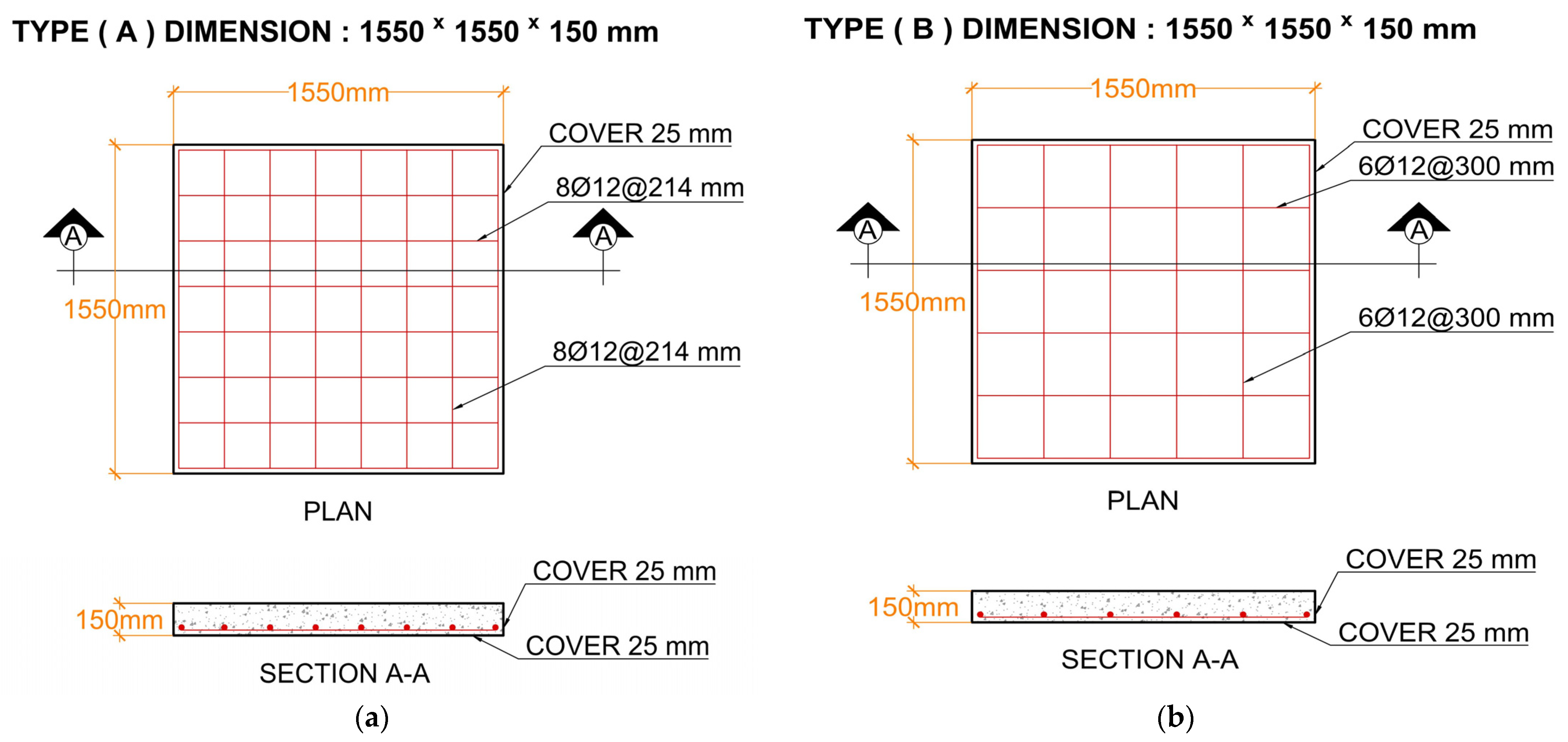
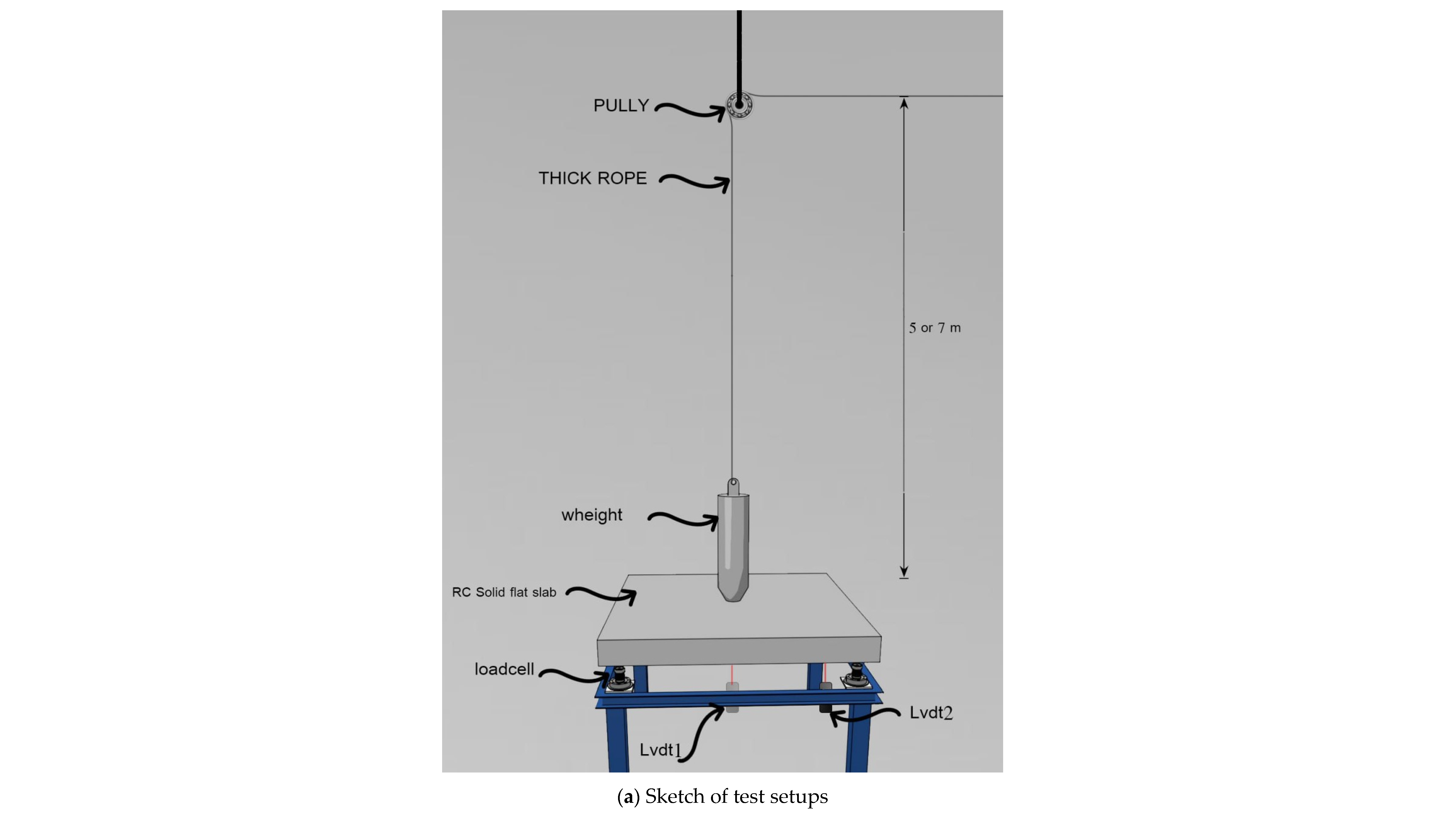
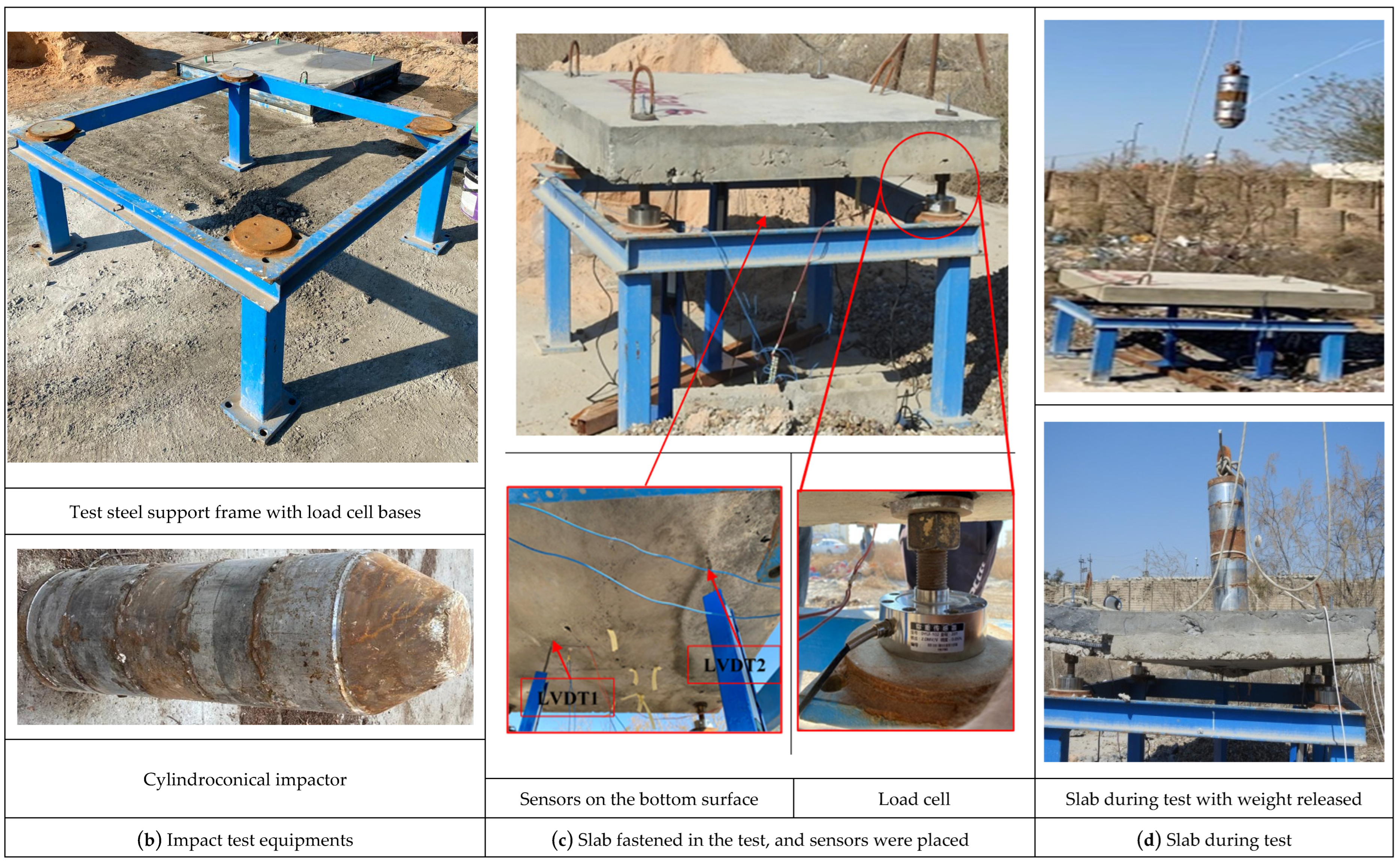



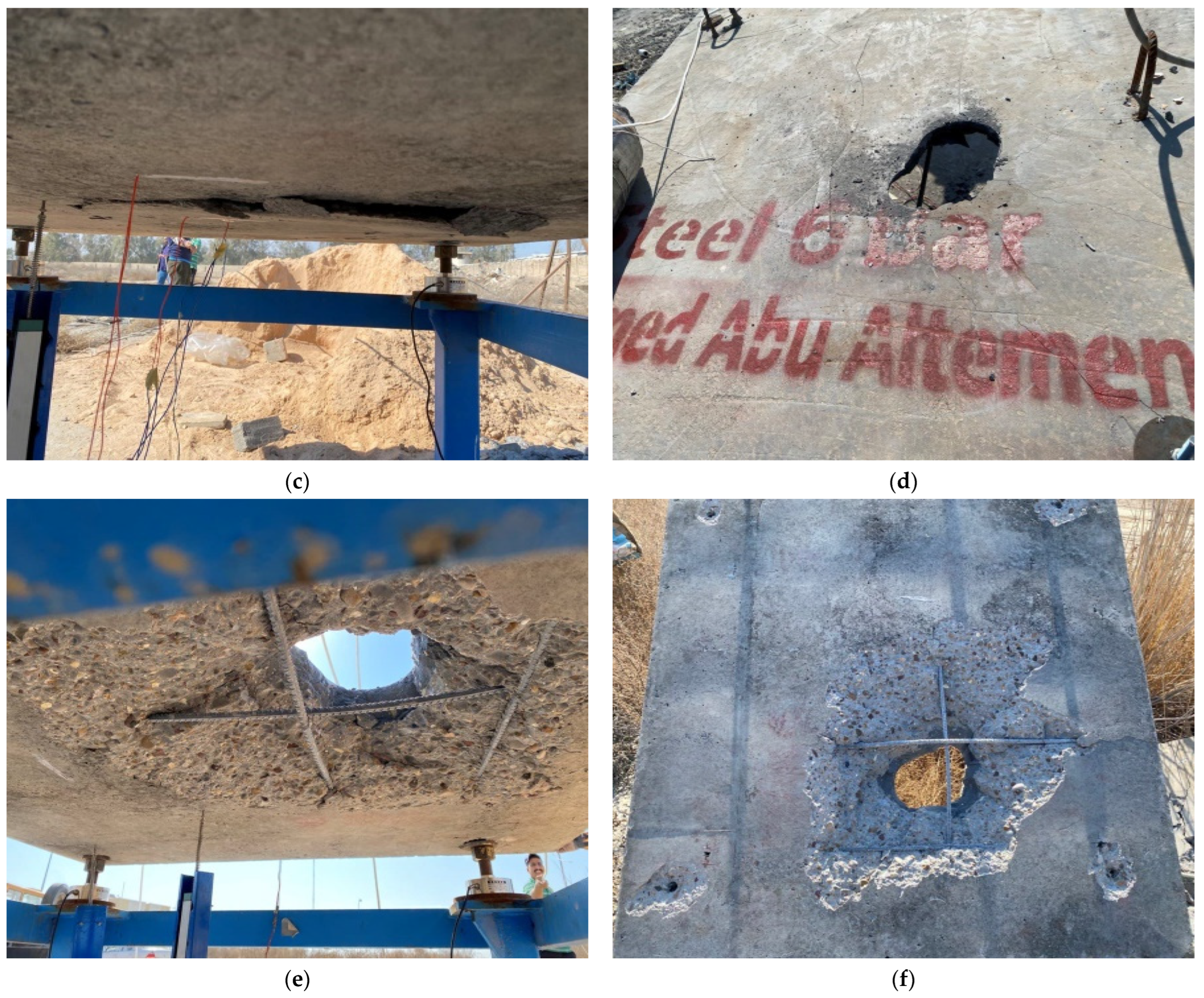

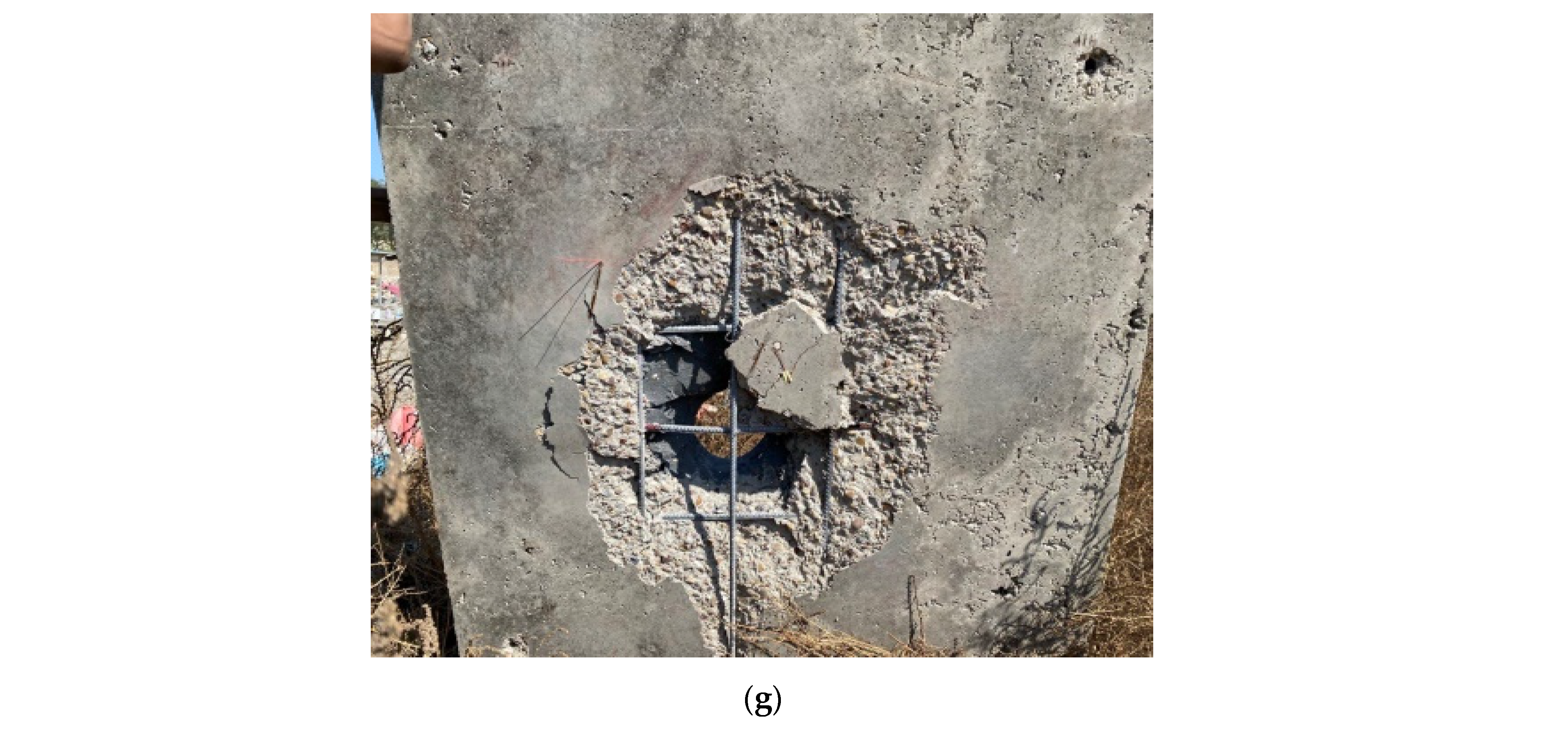
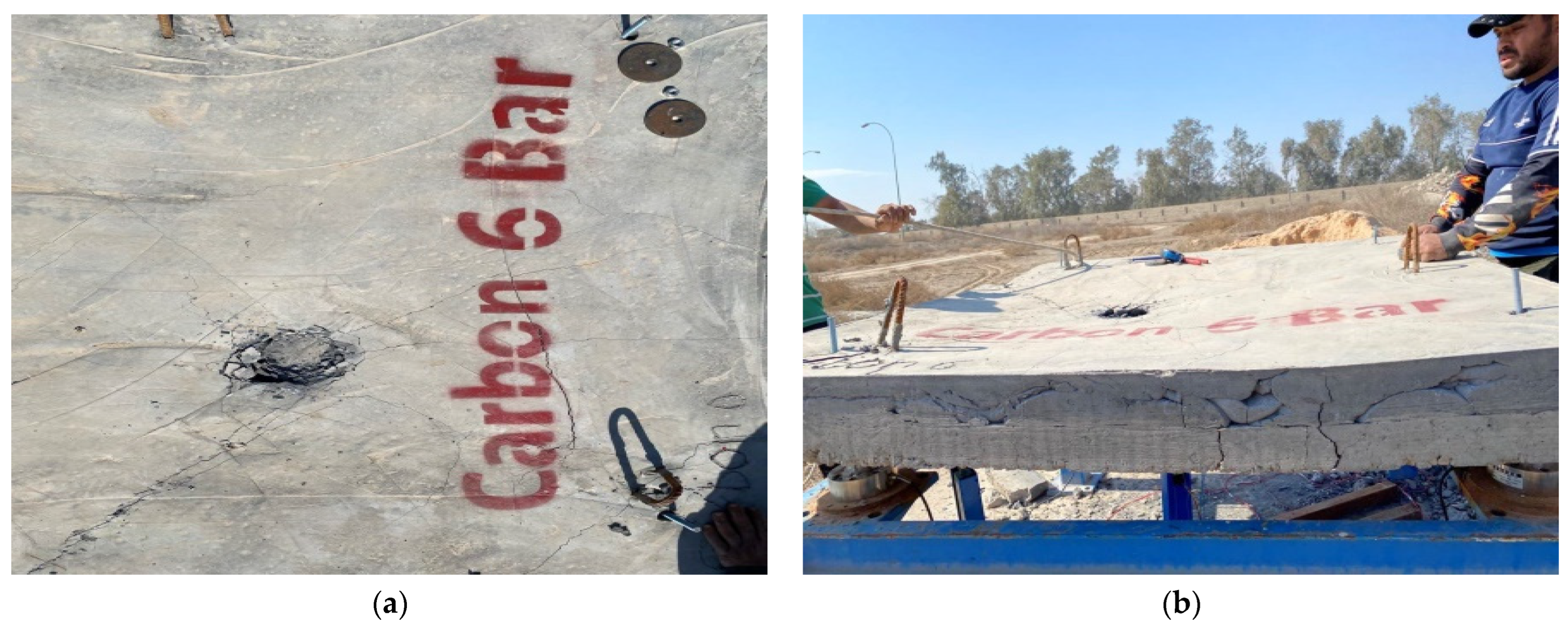
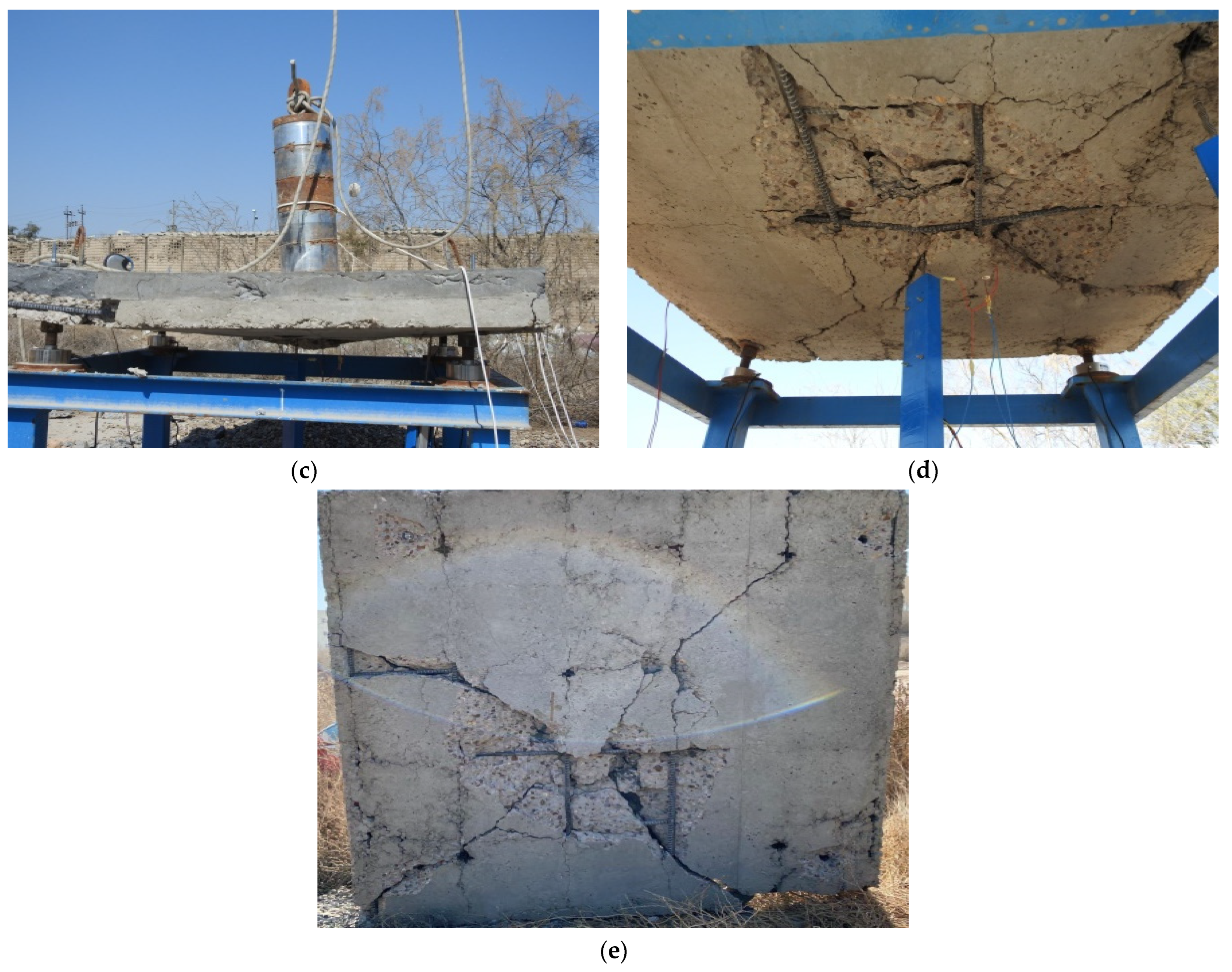
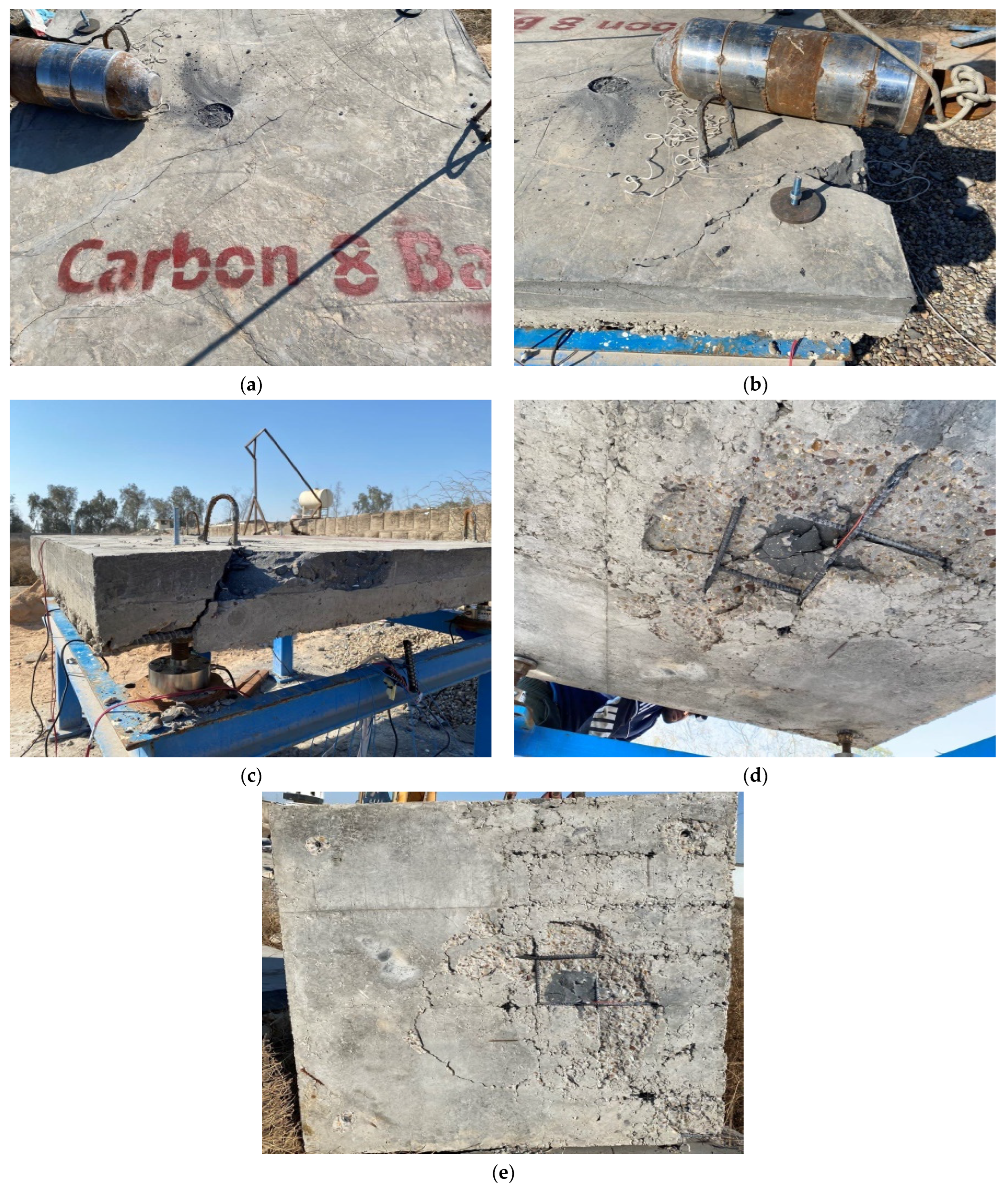


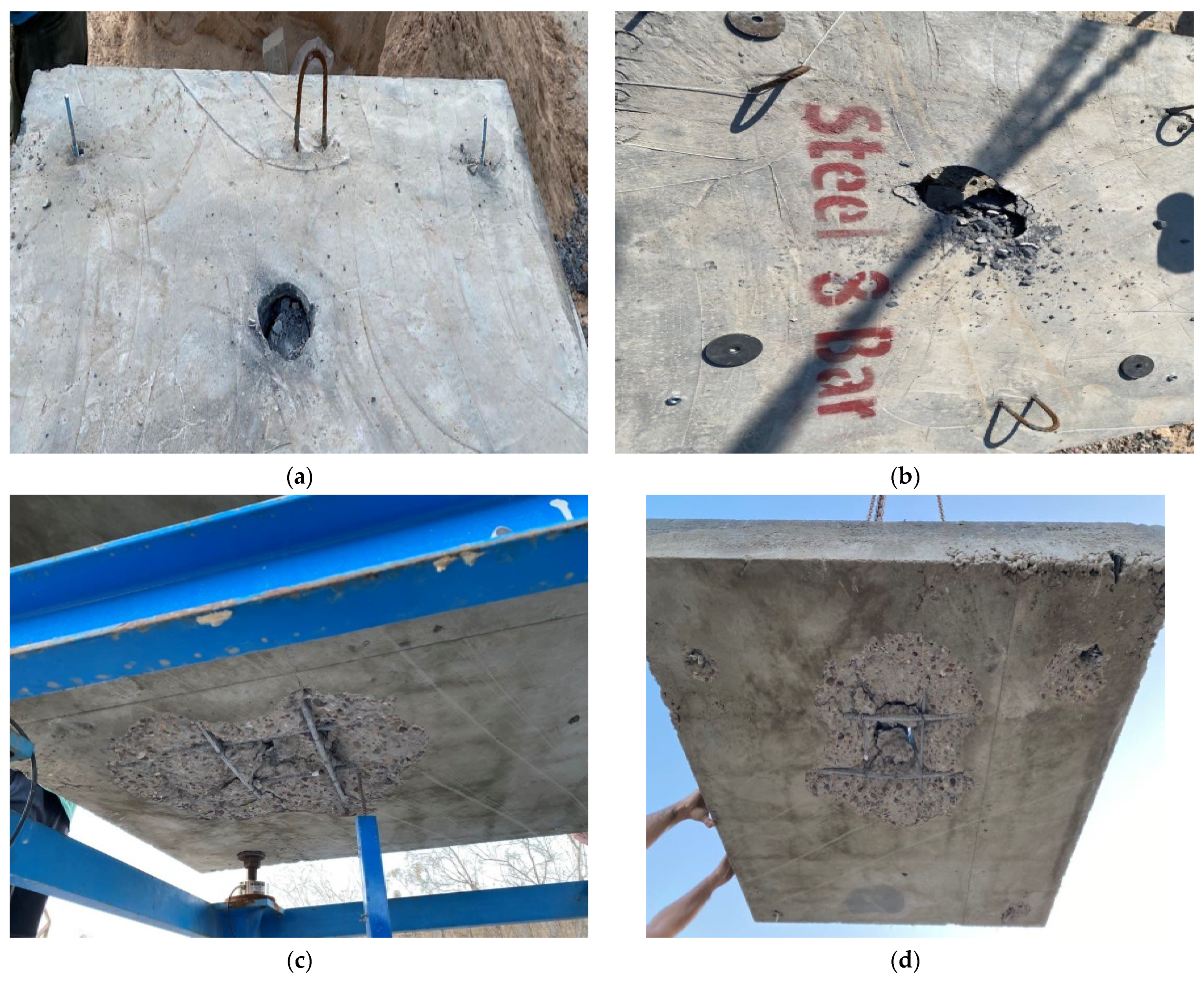
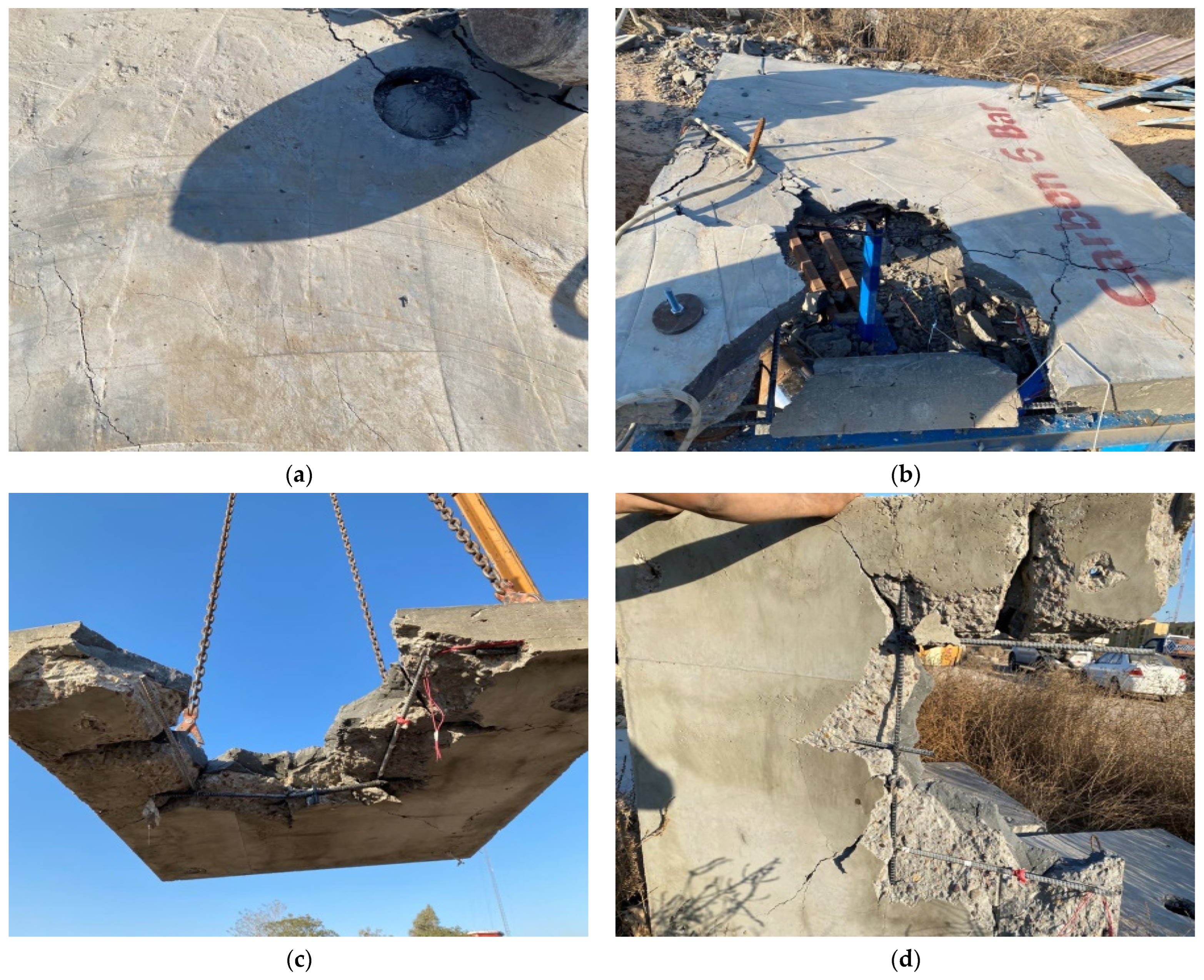
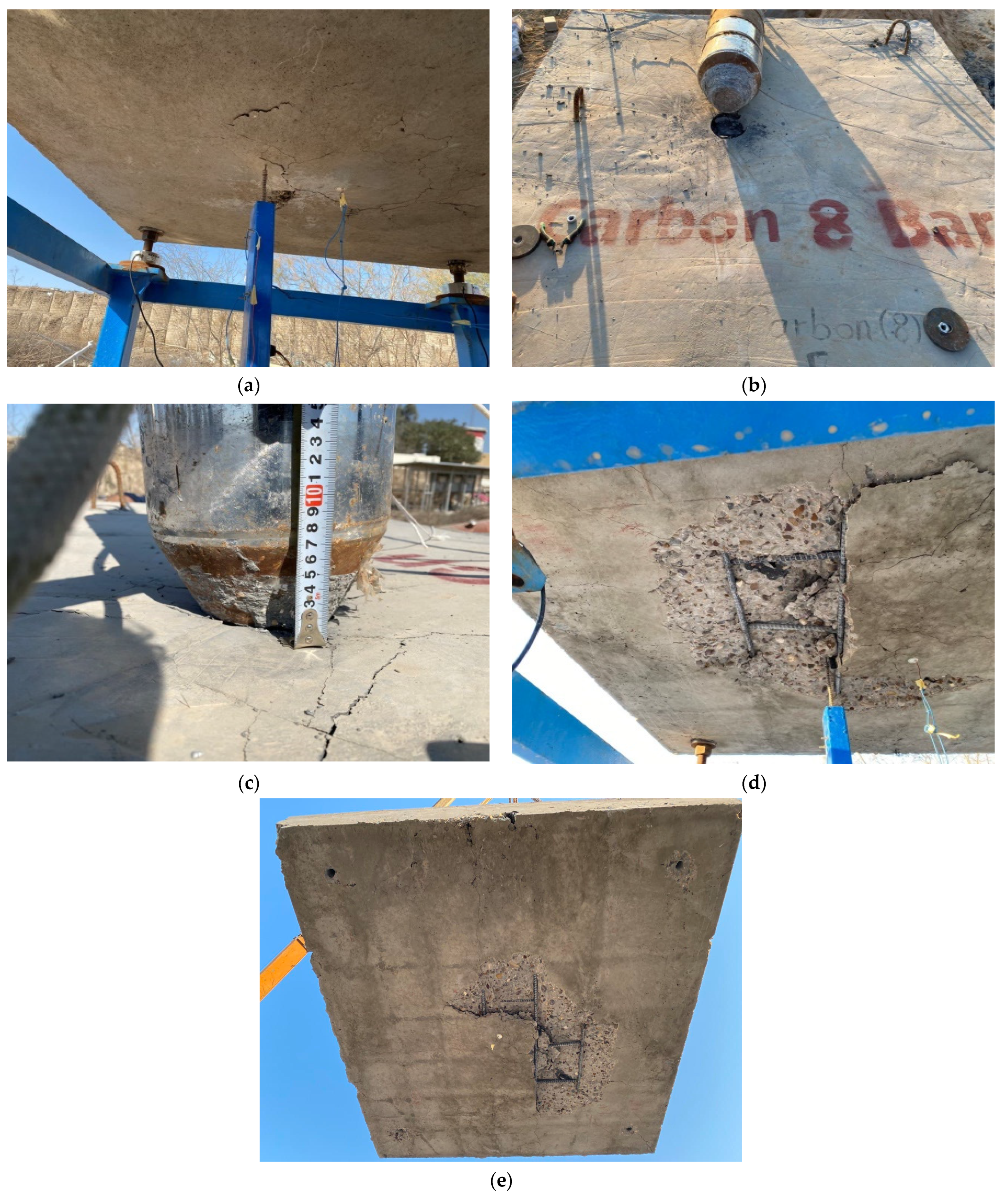
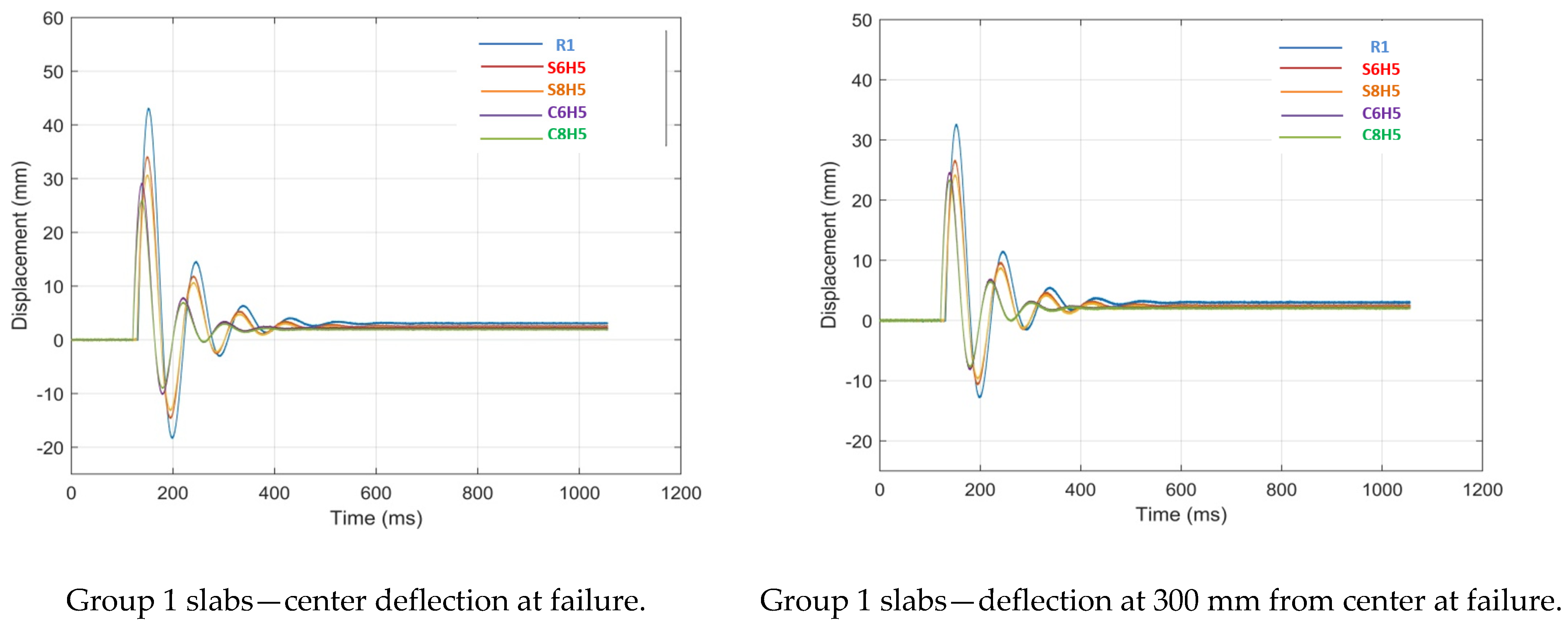
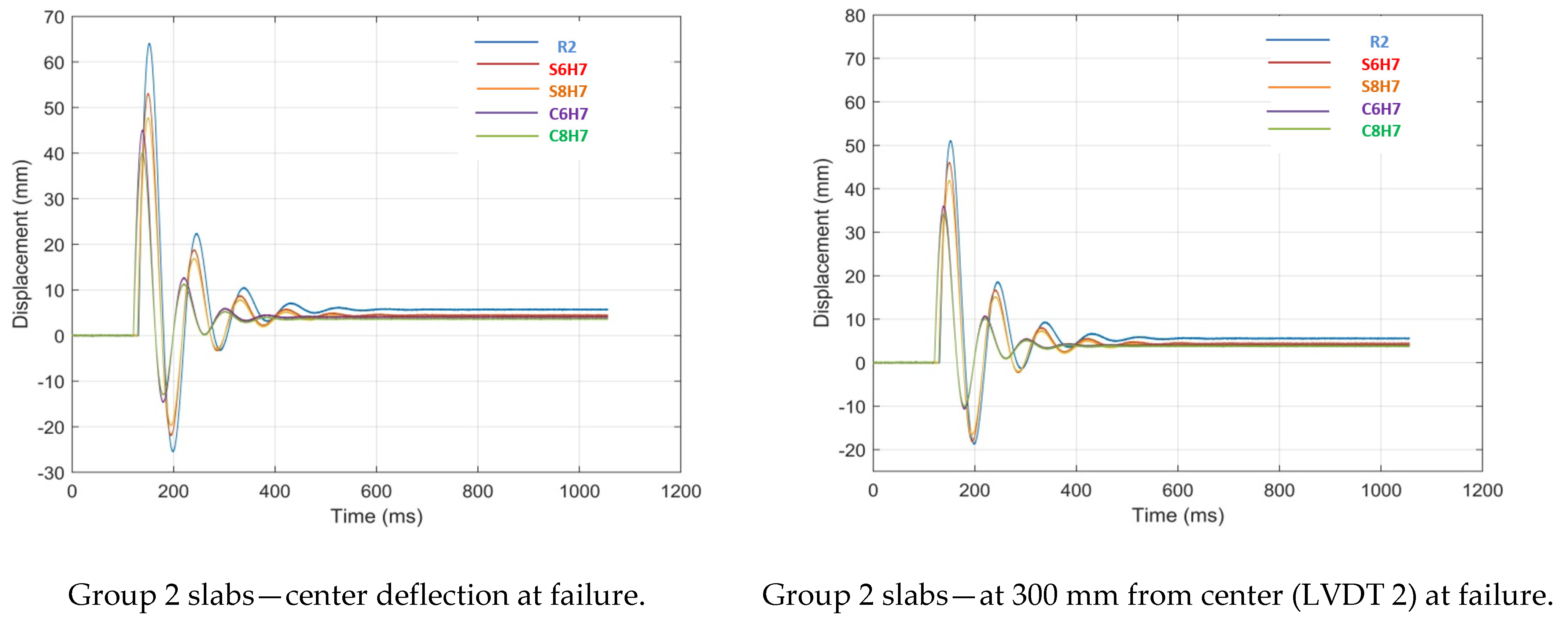
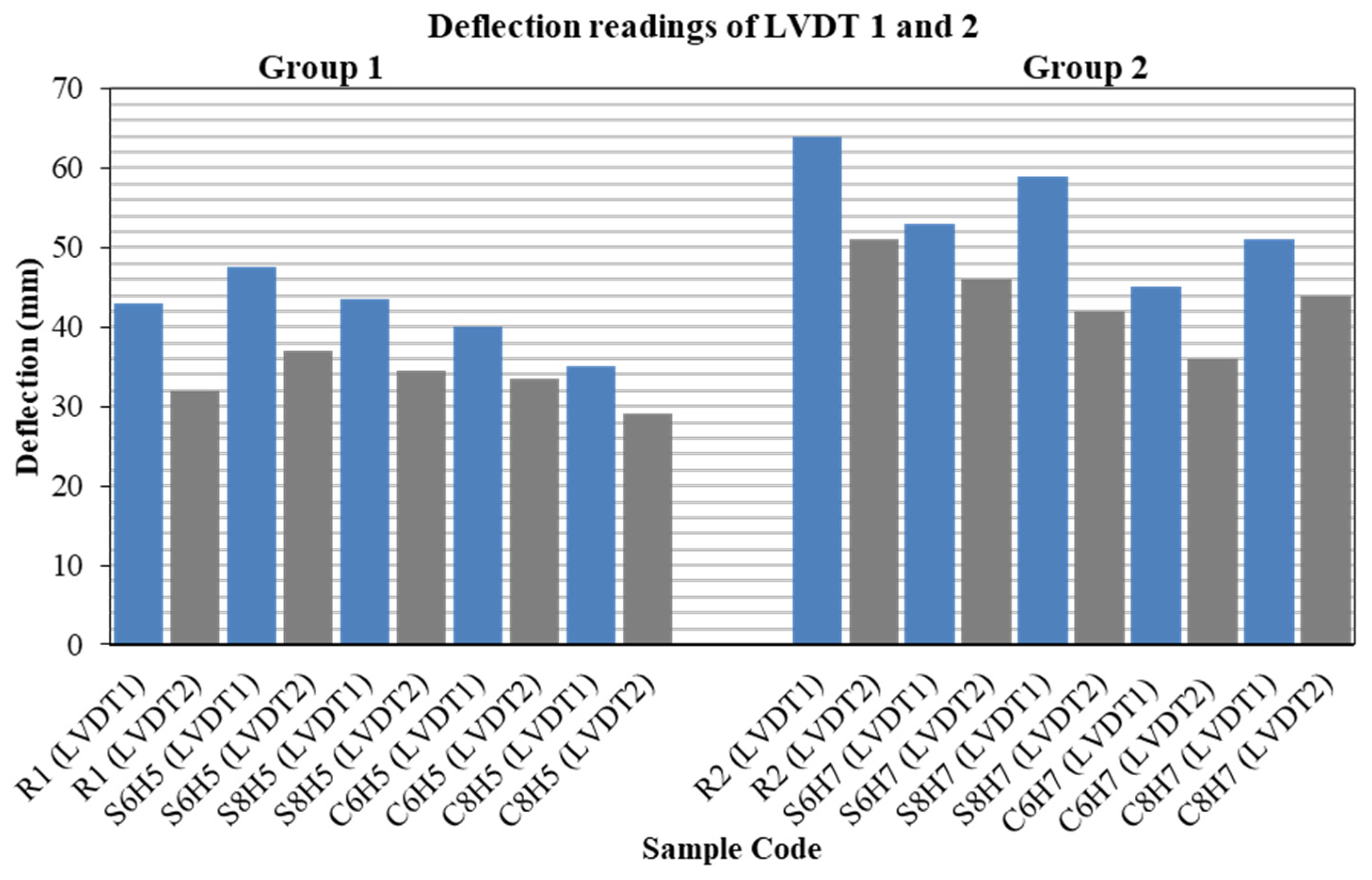

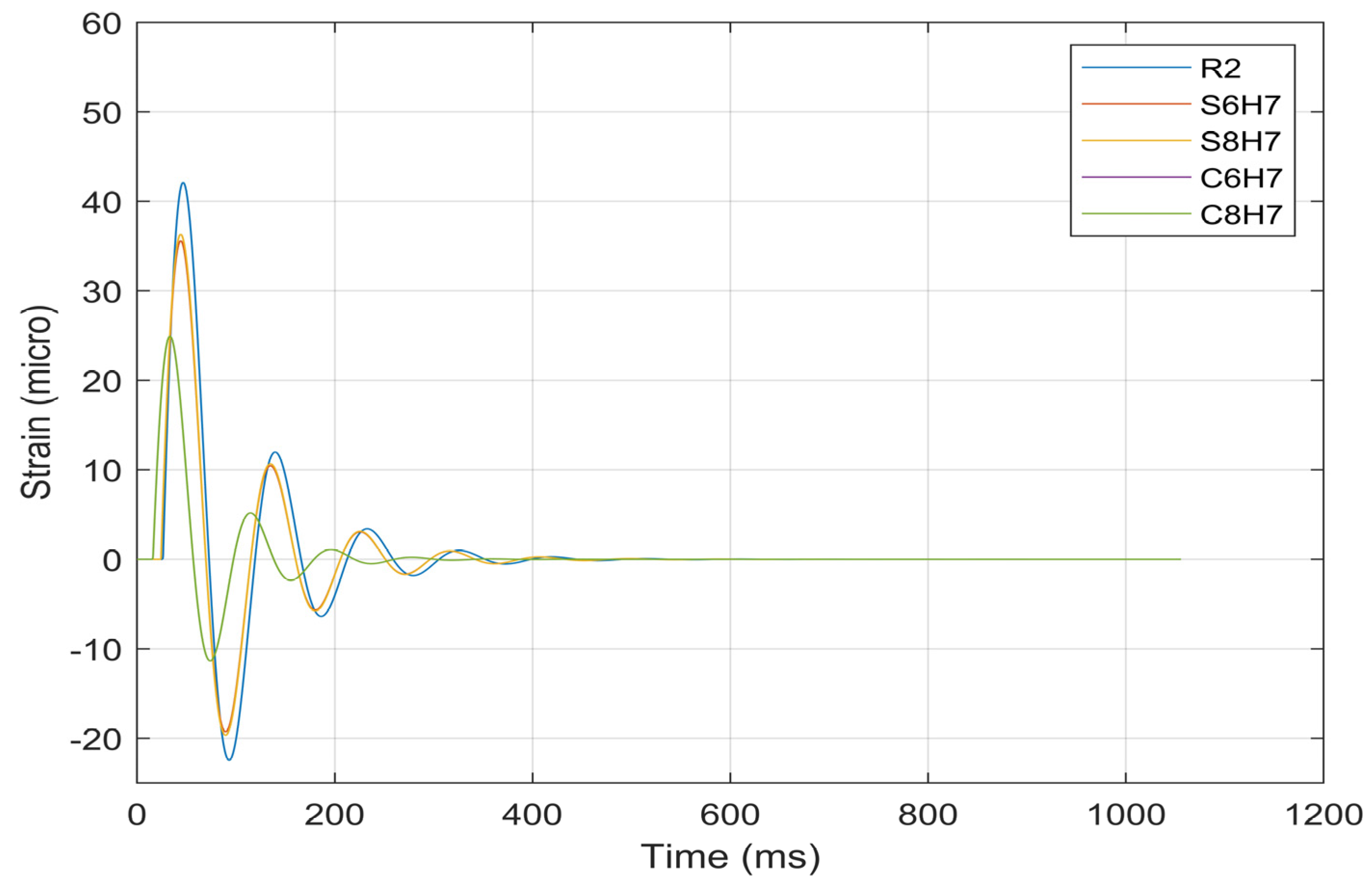
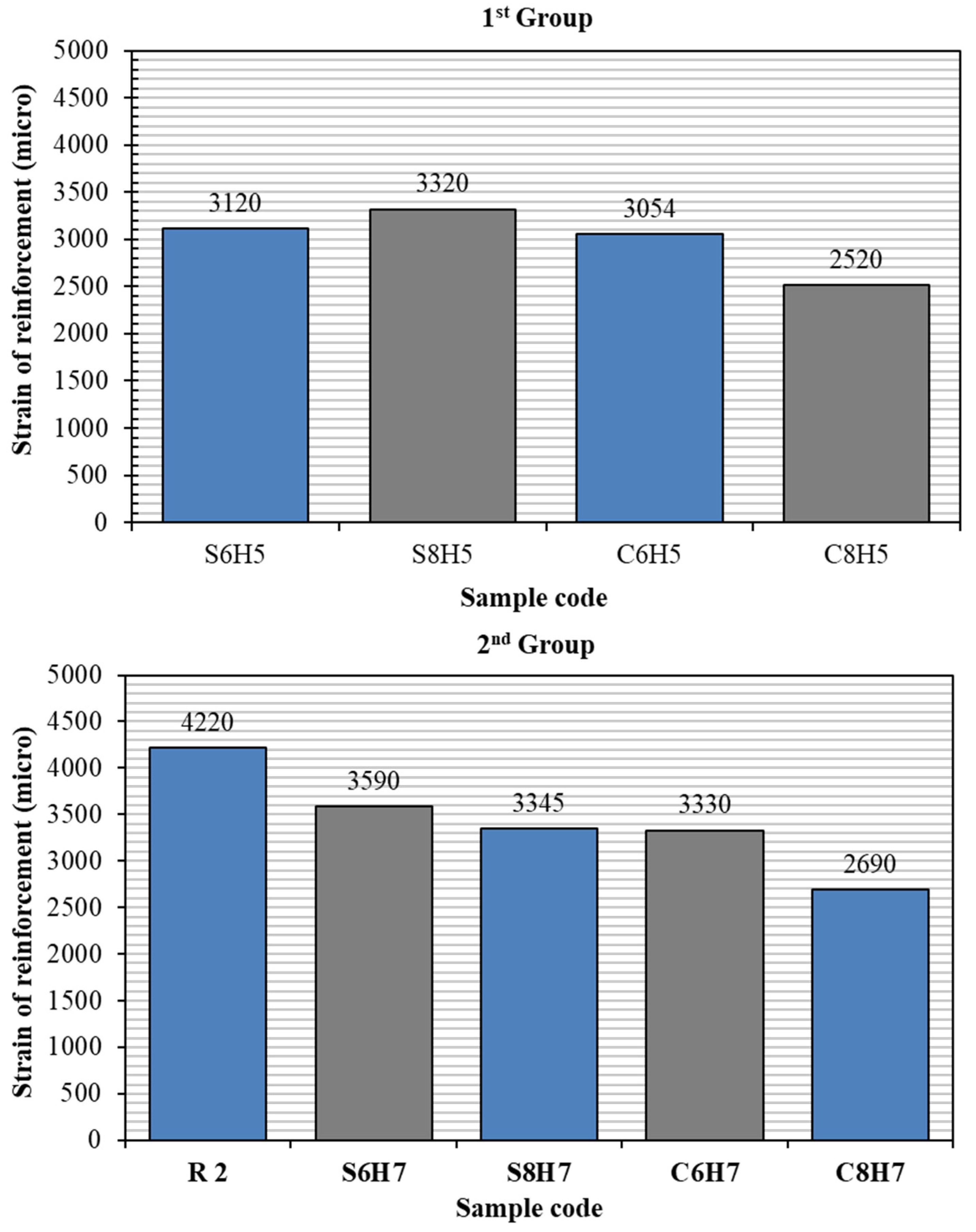
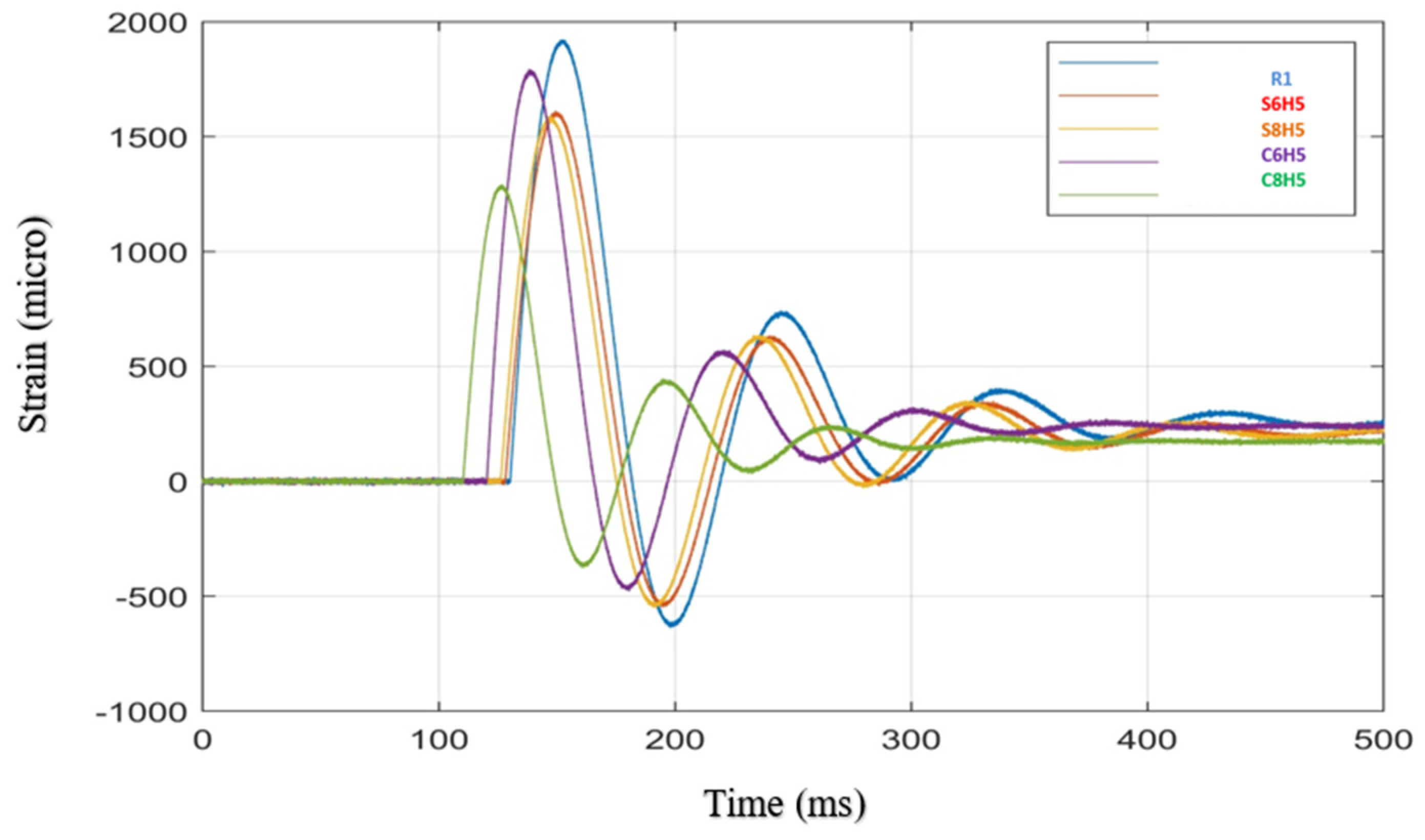
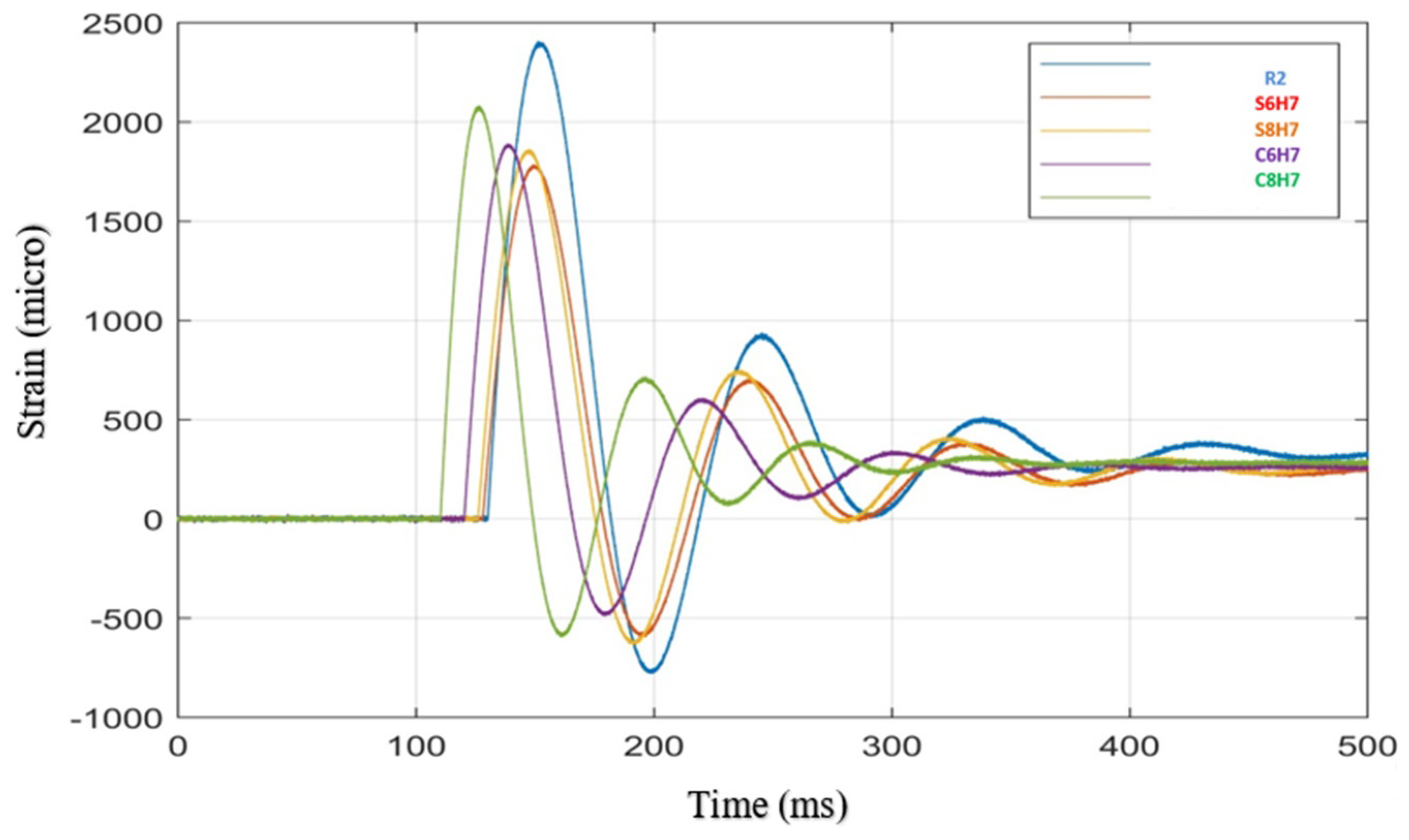
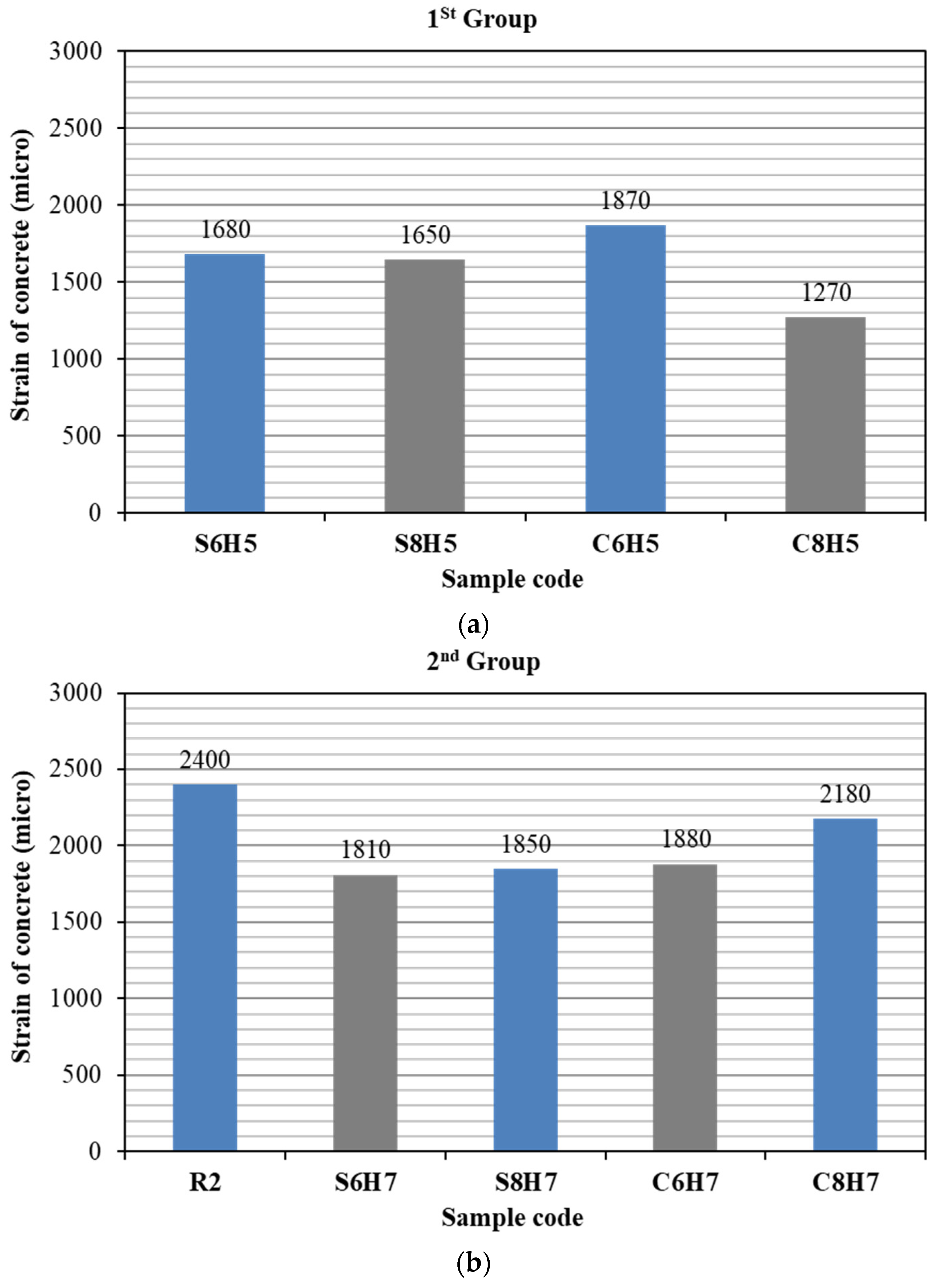
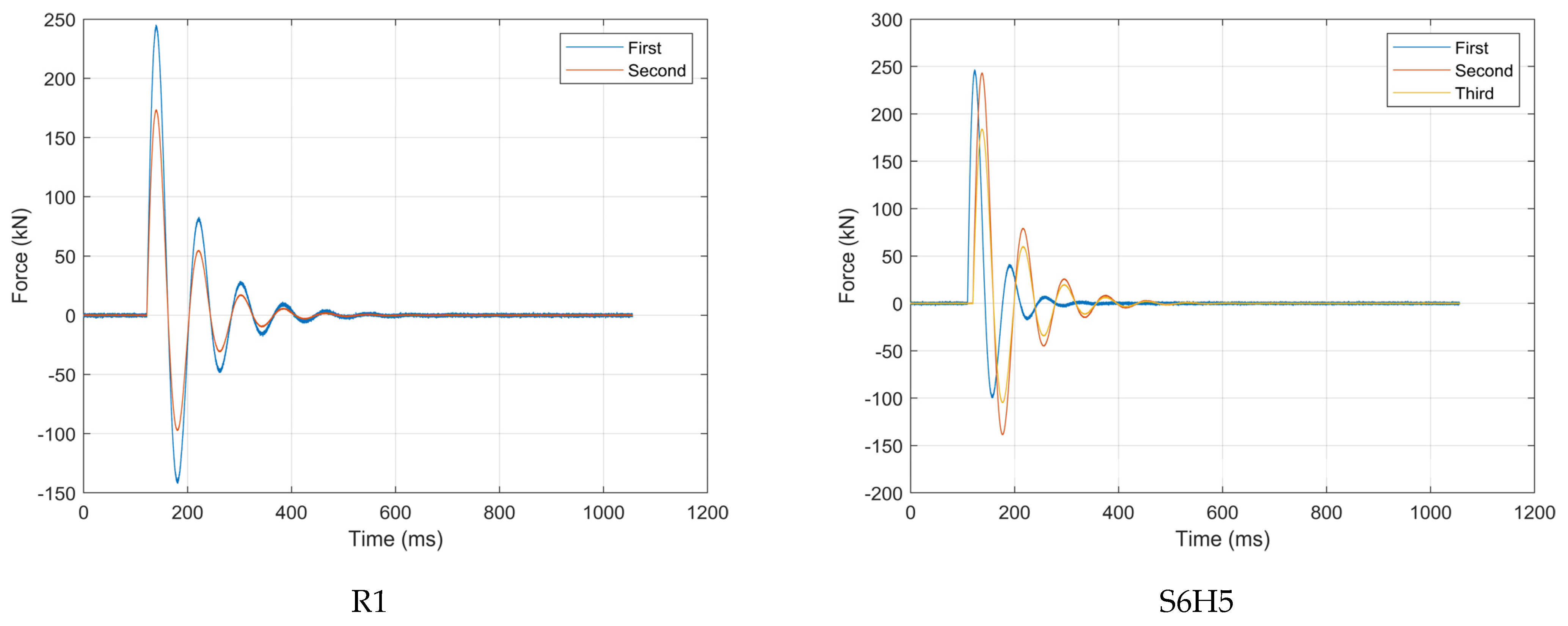

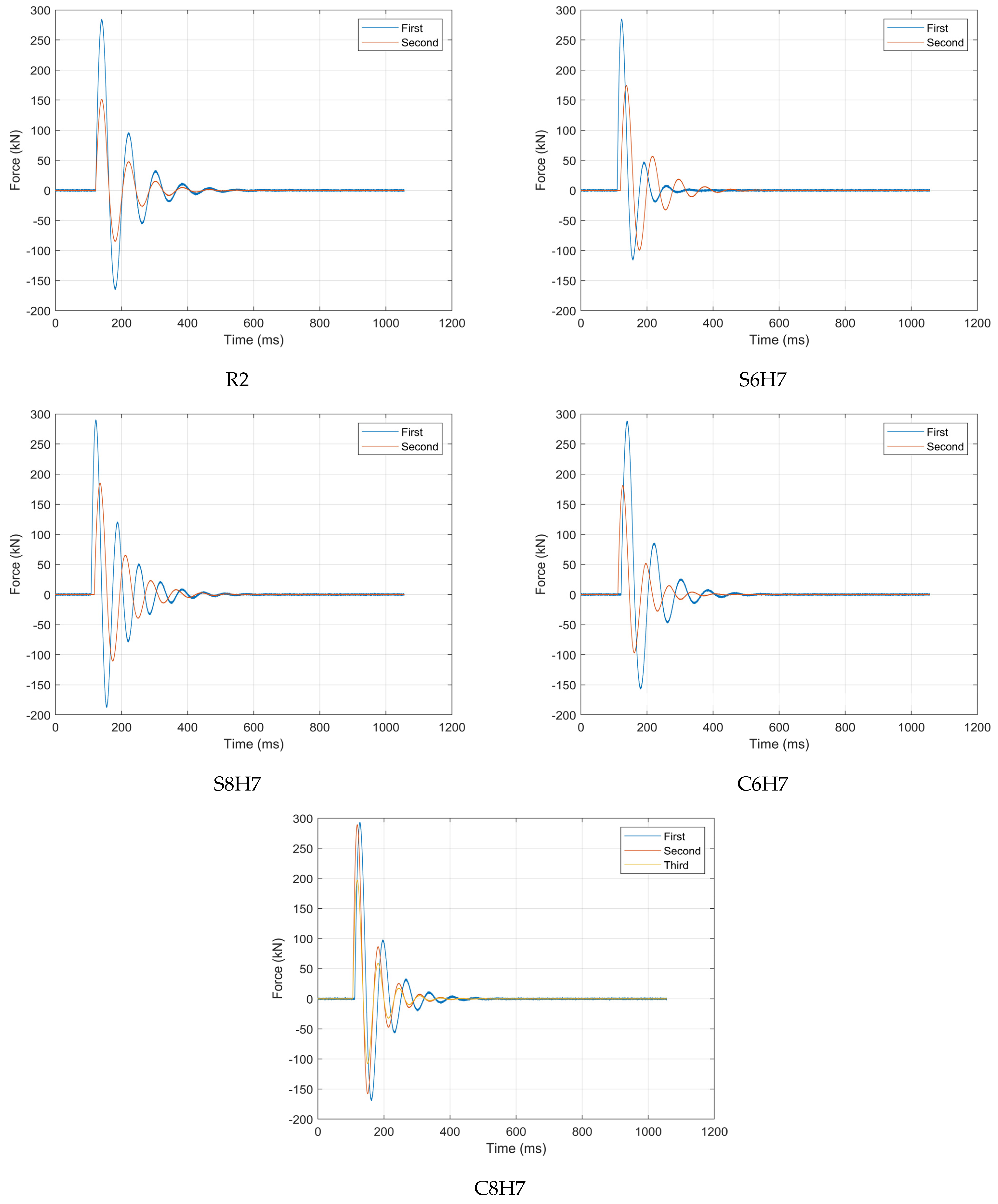
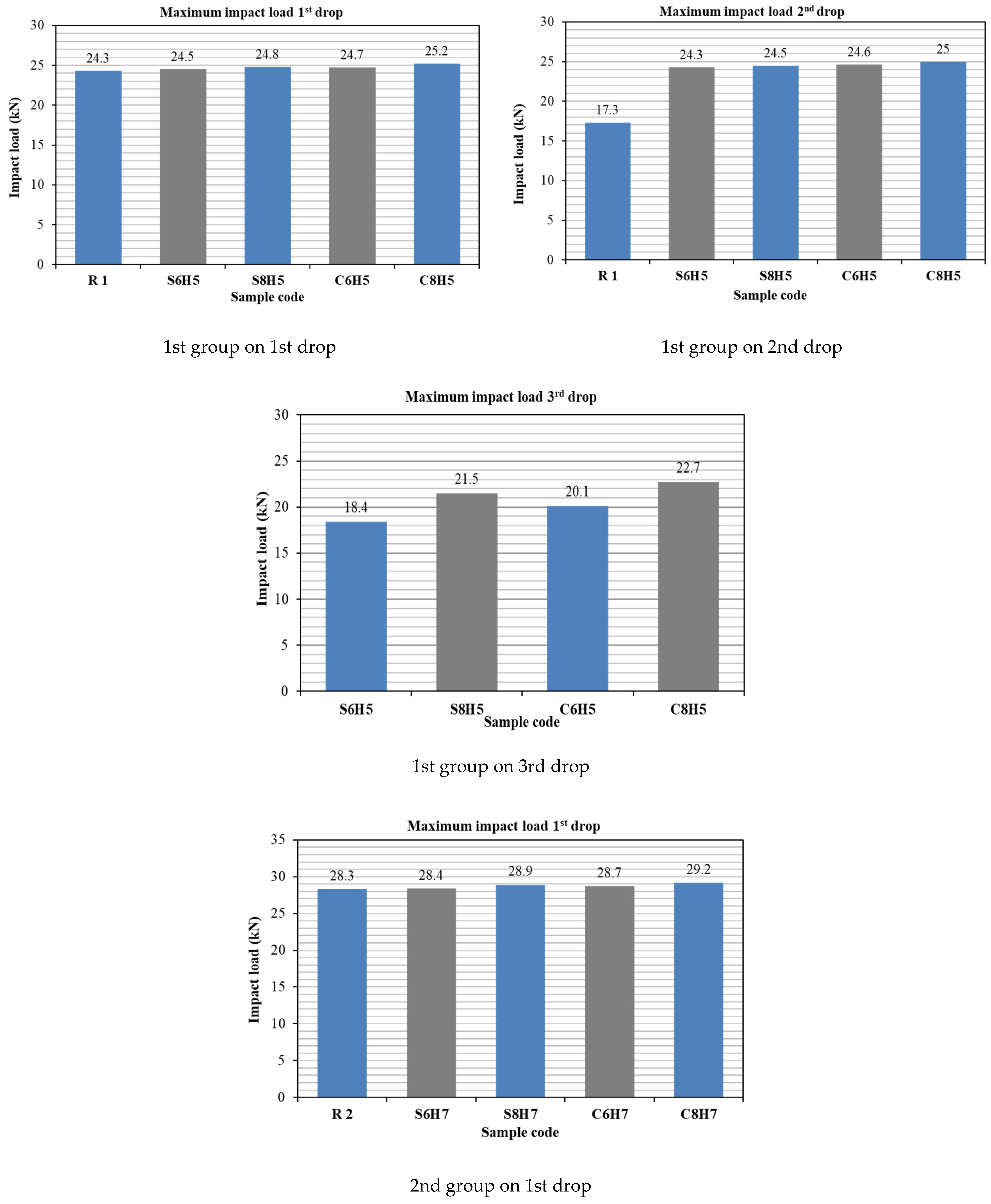
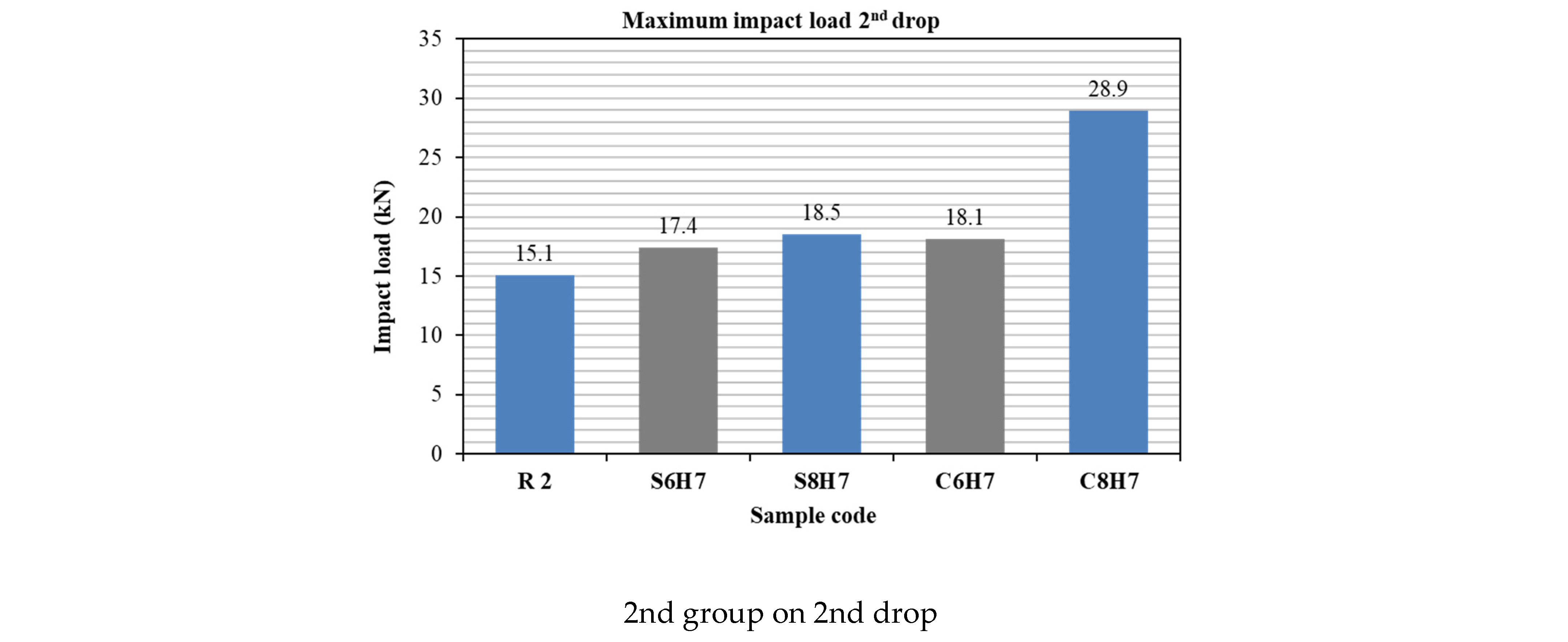
| Chemical Properties (Percentage by Weight) | Physical Properties | ||
|---|---|---|---|
| MgO | 3.40 | Fineness, employing Blaine air permeability apparatus (m2/kg) | 264 |
| CaO | 62.50 | ||
| SiO2 | 21.40 | Soundness, using the autoclave method | 0.67 |
| SO3 | 1.95 | ||
| L.O. I | 2.96 | Compressive strength for cement paste cube at 3 days (MPa) | 18.95 |
| I.R | 1.20 | Setting time, using Vicat’s instrument (initial (min)–final (hour)) | 125–3.93 |
| C3A | 2.76 | ||
| No. | Type of Concrete | Cement 1 | Very Fine Sand 1 | Fine Sand 1 | Gravel 1 | Silica Fume 1 | W/C * | Additive % |
|---|---|---|---|---|---|---|---|---|
| 1 | RPC | 900 | 980 | 0 | 0 | 225 | 0.22 | 0.5 |
| 2 | NC | 350 | 0 | 960 | 1050 | 0 | 0.44 | 0 |
| Mix Type | (MPa) | (MPa) | (MPa) | Young’s (GPa) |
|---|---|---|---|---|
| RPC | 165.1 | 11.33 | 11.23 | 60.37 |
| NC | 29.35 | 5.12 | 6.43 | 25.46 |
| Specimen Code | Type of Concrete | Type of Reinforcement | Reinforcement Ratio (ρ) (%) | Number of Bars | Drop Height | |
|---|---|---|---|---|---|---|
| Group 1 | R1 | NC | Steel | 0.448 | 6 | 5.0 m |
| S6H5 | Hybrid Layered | 0.448 | 6 | |||
| S8H5 | 0.600 | 8 | ||||
| C6H5 | CFRP | 0.448 | 6 | |||
| C8H5 | 0.600 | 8 | ||||
| Group 2 | R2 | NC | Steel | 0.448 | 6 | 7.0 m |
| S6H7 | Hybrid Layered | 0.448 | 6 | |||
| S8H7 | 0.600 | 8 | ||||
| C6H7 | CFRP | 0.448 | 6 | |||
| C8H7 | 0.600 | 8 | ||||
| Group One (The Drop Height Is 5.0 m.) | Group Two (The Drop Height Is 7.0 m.) | ||
|---|---|---|---|
| Specimen Name | Number of Drops | Specimen Name | Number of Drops |
| R1 | 2 | R2 | 2 |
| S6H5 | 3 | S6H7 | 2 |
| S8H5 | 3 | S8H7 | 2 |
| C6H5 | 3 | C6H7 | 2 |
| C8H5 | 3 | C8H7 | 3 |
Disclaimer/Publisher’s Note: The statements, opinions and data contained in all publications are solely those of the individual author(s) and contributor(s) and not of MDPI and/or the editor(s). MDPI and/or the editor(s) disclaim responsibility for any injury to people or property resulting from any ideas, methods, instructions or products referred to in the content. |
© 2024 by the authors. Licensee MDPI, Basel, Switzerland. This article is an open access article distributed under the terms and conditions of the Creative Commons Attribution (CC BY) license (https://creativecommons.org/licenses/by/4.0/).
Share and Cite
Abu Altemen, A.A.G.; Medhlom, M.K.; Özakça, M. Structural Behavior of Full-Scale Novel Hybrid Layered Concrete Slabs Reinforced with CFRP and Steel Grids under Impact Load. Buildings 2024, 14, 2625. https://doi.org/10.3390/buildings14092625
Abu Altemen AAG, Medhlom MK, Özakça M. Structural Behavior of Full-Scale Novel Hybrid Layered Concrete Slabs Reinforced with CFRP and Steel Grids under Impact Load. Buildings. 2024; 14(9):2625. https://doi.org/10.3390/buildings14092625
Chicago/Turabian StyleAbu Altemen, Ahmed Abbas Ghali, Mu’taz Kadhim Medhlom, and Mustafa Özakça. 2024. "Structural Behavior of Full-Scale Novel Hybrid Layered Concrete Slabs Reinforced with CFRP and Steel Grids under Impact Load" Buildings 14, no. 9: 2625. https://doi.org/10.3390/buildings14092625
APA StyleAbu Altemen, A. A. G., Medhlom, M. K., & Özakça, M. (2024). Structural Behavior of Full-Scale Novel Hybrid Layered Concrete Slabs Reinforced with CFRP and Steel Grids under Impact Load. Buildings, 14(9), 2625. https://doi.org/10.3390/buildings14092625






